Don't wanna be here? Send us removal request.
Text
Video SEO: How to Rank YouTube Videos on Google
Looking to get more YouTube video views from Google? Google has sent over 160,000 views to our YouTube videos in the last ~12 months.

That’s more views than the countless video embeds on our blog have sent us, which currently gets over 250,000 organic visits per month. In this post, you’ll learn how to rank your YouTube videos on Google in 5 easy steps. We’ve also included a few bonus tips on how to use videos to get more website traffic. But first, let’s make sure we’re on the same page…
What is video SEO?
Video SEO is the process of getting more video views from Google and utilizing videos to increase organic traffic to your website. In this guide, we’ll focus mainly on the first part: getting more views from Google. What we’re not going to talk about is ranking videos higher on YouTube. If that’s your goal, read our full guide to YouTube SEO.
How to rank YouTube videos on Google
Follow these five steps: Find topics with “traffic potential” Create an “optimized” video Fix the closed captions Upload an enticing thumbnail Add timestamps Let’s go through each of these in more detail. Step 1. Find video topics with “traffic potential” Not every video has the potential to attract views from Google. For instance, here’s a video with over 2.2 million views on YouTube:

Yet it doesn’t rank on Google for anything:

The reason for this is simple: For a video to attract views from Google, two things have to be true: People need to be searching on Google for that topic. If nobody is searching for it, then nobody will click on your video even if it ranks. The topic must have “video intent.” This means that most searchers would prefer to watch a video about the subject instead of reading about it. Keyword research tools can help with finding topics that people are searching for. You can then look for videos in the search results to infer “video intent.”
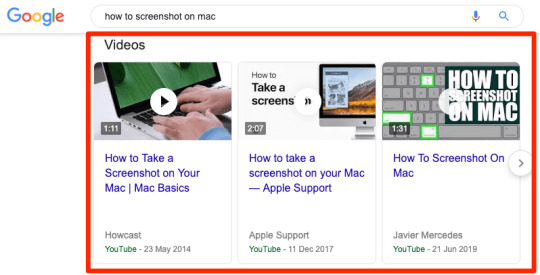
Example of a search query with video results in a carousel. The logic here is that because Google aims to give users what they want, seeing videos in the search results is a clear sign that searchers want to watch a video. The question is, how can you find these topics easily? Simple. Look for relevant videos that get lots of traffic from Google, as these are clearly about topics with “video intent” that lots of people are searching for. Here are three ways to do that: 1. Use Content Explorer Content Explorer lets you search a database of over 1.1 billion web pages for mentions of a particular word or phrase. Within that index, there are currently over 47 million pages from YouTube. To get started, run this search: site:youtube.com inurl:watch title:topic

Sort the results by search traffic from high to low. This should give you a list of relevant YouTube videos that currently get organic search traffic.
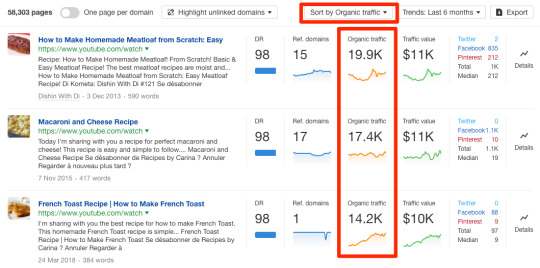
For example, the macaroni and cheese video above gets an estimated 17,400 clicks from organic search every month. If you had a cooking channel, it might be worth creating a video on this topic. QUICK TIP When looking for ideas in Content Explorer, it’s worth eyeballing the “Organic traffic” graph for the past six months to make sure that traffic is consistent over time.

2. Use Site Explorer Head to Site Explorer and search for youtube.com. Go to the “Organic keywords” report, then add a relevant keyword to the “Include” filter.
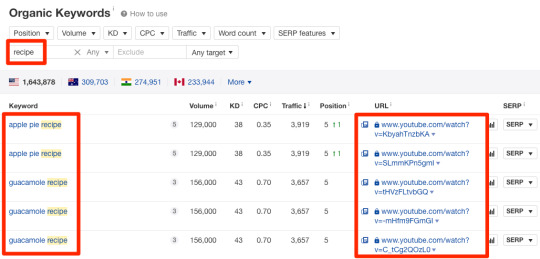
Here, we see YouTube videos ranking for queries that include the word “recipe.” If we click the caret next to any of these URLs, we see their estimated worldwide monthly organic traffic.

For example, this video gets ~13,000 monthly organic visits. If we click on the video URL, we see that it’s a Belgian waffle recipe, so this is another topic that may be worth covering on a cooking channel. QUICK TIP Before pursuing a topic, hit the “Overview” link on the caret and check the “Organic traffic” graph to make sure that it’s consistent over time. You want to see a graph like this…

… not like this:

A big traffic spike followed by a small amount of traffic for a long period is a sign of a topic with waning interest. 3. Use Google and Ahrefs’ Batch Analysis tool Add this free SERP scraper to your browser, then run this search on Google: site:youtube.com Next, go to Settings > Search settings > then set the results per page to 100.

Go back to the results and hit the SERP scraper to download the results.

Open the downloaded CSV, then copy-paste the YouTube URLs into Ahrefs’ Batch Analysis tool. Set the mode to “URL” and hit “Analyze.”

Sort the results by the “Traffic” column to see which videos get the most organic search traffic.

Consider making videos about these topics. Step 2. Create an “optimized” video Learning how to make YouTube videos that people love is beyond the scope of this guide. But we are going to cover a few things to keep in mind during the creation process that may help you rank in Google SERP features like “key moments” and “suggested clips.”

Key moment SERP feature in Google.

Suggested clip SERP feature in Google. Both of these have the potential to send more views to your videos. For now, let’s focus our attention on “suggested clips.” (We’ll cover “key moments” in step #5). Judging by Google’s research paper, the way suggested clips are chosen from a technical standpoint isn’t that straightforward. So instead of focusing on the technicalities, let’s focus on actionable steps to take that may you help win them. The first is to use simple language and “action verbs” to describe each step in the video. For example, if your video tells people how to cook rice, simple spoken instructions may be: To begin, wash the rice with cold water. Repeat this process three times, then tip the rice into a pan. Add fresh water, bring to a boil, cover, then simmer for 15–20 minutes. Drain the excess water and serve. Make sure to avoid unnecessary fluff and distractions between instructions where possible. In other words, don’t go off on a tangent explaining how your mom once deviated from one of the steps and ended up with burnt rice. This will only reduce clarity, which may confuse Google’s language processing algorithms. The second is to ensure that your audio is clear and high quality. To do this, use a decent microphone and keep background noise to a minimum. The third is to show what you’re talking about on the screen as you talk about it. For instance, if you tell people to “put the pan on the hob,” show footage of that process on screen as you do so. This may increase Google’s confidence that the spoken instructions align with the content of the video. Recommended reading: Video Featured Snippets: How Suggested Clips Work Step 3. Fix your closed captions YouTube automatically adds closed captions to videos. The problem is that these are rarely perfect. Misspelled words and grammatical errors are a common issue. Just take a look at these auto-generated captions from one of our old YouTube videos:

YouTube thinks Tim is saying “team solo from a traps” when he’s actually saying “Tim Soulo from Ahrefs.” For that reason, it’s best to add your own. Here’s what one of the videos on YouTube’s Creator Academy says about CC’s: In terms of search, discovery, and engagement, captions are one of the most powerful pieces of data out there. The internet is text-based, so your video is going to stay hidden from search engines unless the text attached to it can be picked up. It can be hard to get across the essence of your video in just a title or description, even tags have a character limit. But a closed-caption file delivers a text-based transcript of your entire video and opens it up to search engines. That same video goes on to say: Text on screen has proven to be so engaging that it increases the watch to completion rate. These two factors lead to a monumental gain in SEO ranking and engagement. Given these quotes, it seems that adding CC’s helps with two main things: Understanding your video. Google won’t rank your video without understanding what it’s about, and closed captions appear to help with that. Engagement. Lots of people watch videos in noisy or sound-sensitive environments, and over 5% of the world’s population has hearing loss of some degree. Closed captions help ensure that your video is useful to more people. That improves engagement, which, in turn, may lead to higher rankings in Google. It’s also worth noting that if you’ve scripted your video, it doesn’t take long to fix closed captions manually, so it’s well worth doing. Step 4. Upload an enticing thumbnail Videos with poor thumbnails won’t get as many clicks from Google as those with enticing ones. Here’s an example of a lousy thumbnail in a video carousel for the query, “how to make pancakes”:
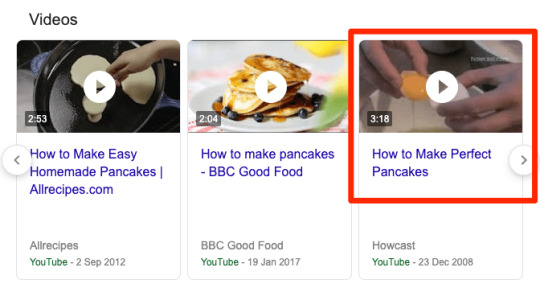
Not only is this visually dull and uninspiring, but the thumbnail shows an egg, not pancakes. Here are a few tips for creating thumbnails that entice searchers to click: Use a custom thumbnail Don’t choose a still from your video. Create a custom and enticing thumbnail to grab the searcher’s attention. Use the correct aspect ratio Google shows video thumbnails in the 16:9 format. As a result, those with other aspect ratios can look odd in the search results, and that may dissuade the click.
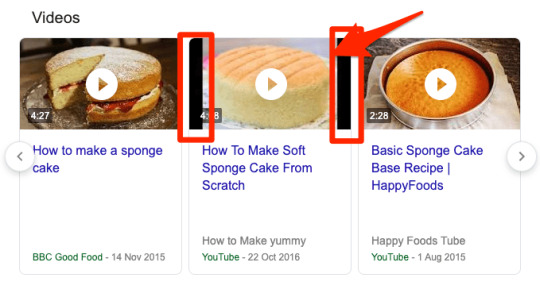
Use a congruent image Create a thumbnail that visually demonstrates that the video solves the user’s query. For example, if someone searches for “how to tie a tie,” then this thumbnail makes sense because it shows someone tying a tie:

On the other hand, this one doesn’t make much because you can barely tell that the kid is wearing one:

Use contrast to your advantage Avoid colors like white, grey, and red on your thumbnail as they blend in with search results. Instead, use contrasting colors that stand out. We tend to use dark blue and orange.

Use descriptive text on the thumbnail This is something we do for all of our YouTube videos. For example, our video about learning SEO has the words “Learn SEO” on the thumbnail.
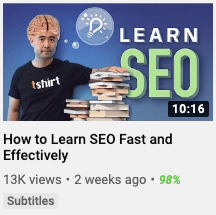
Usually, we go for something short that compliments the title of the video. Whatever text you use, make sure that it’s written in an easy-to-read font, and looks good at both small and large sizes. Step 5. Add timestamps Earlier, we briefly mentioned the “key moments” that Google sometimes shows in search results.

Here’s what Google says about these: When you search for things like how-to videos that have multiple steps, or long videos like speeches or a documentary, Search will provide links to key moments within the video You’ll be able to easily scan to see whether a video has what you’re looking for, and find the relevant section of the content. Google also says: If your video is hosted on YouTube, Google Search may automatically enable clips for your video based on the video description on YouTube, and you may not have to mark specific timestamps in your YouTube description. However, you can tell us more explicitly about the important points in your video and we will prefer that information. Long story short, Google is probably more likely to show “key moments” for your videos if you mark important points in the YouTube description. To do that, use timestamps and labels. What’s a timestamp? This is when a clip starts in the :: format. You can negate the if it’s not needed. Video timestamps are automatically linked. What is a label? This is a brief and clear description of the clip. You can see an example of timestamps and labels on our video about YouTube SEO.
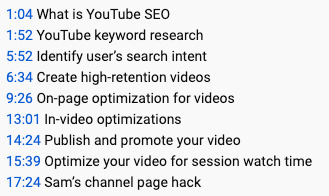
These nine timestamps take viewers to sections of the video about what YouTube SEO is, YouTube keyword research, identifying search intent, and so forth. Seemingly thanks to these optimizations, Google now shows “key moments” for our video for the query, “how to rank YouTube videos.”

The same is true for our video about link building with Google sheets.

Here are some tips for adding timestamps and labels: Add timestamps to the video description. Don’t place it in a pinned comment. Place each timestamp on a new line. Specify the label on the same line. Keep the label brief but descriptive. Your label should be a direct statement of what the section is about (e.g., “Boil the pasta” not “Put your pasta in the pan and cook it for 10–15 minutes until al dente”) List timestamps in chronological order. Don’t add a timestamp for something at the end of your video before earlier points. Keep labels to around 40 characters or less. Google truncates longer ones. Don’t add too many timestamps. Google hasn’t mentioned a maximum or a minimum number of timestamps they’ll show in search results. However, it’s unlikely that they’ll show a carousel with hundreds of them. As a general rule of thumb, we’d recommend no more than ten timestamps per video. Align the on-screen content with the label. If your label says “Chop the onion,” try to add the timestamp when you’re visibly chopping the onion on the screen. Note that “key moment” results are only available for YouTube videos at present, so this isn’t something that works for videos hosted elsewhere. However, Google has said they’re planning to introduce support for other videos soon. We’re also introducing a way for more content creators across the web to mark up their videos so they can be more easily searchable. Soon you’ll be able to find these key moments from video publishers around the world, such as CBS Sports and NDTV, as they add markup to their videos
Bonus tips: How to use videos to get more website traffic
Video SEO is not only about getting more YouTube video views from Google. It also involves utilizing videos to attract more traffic to your website from organic search. Below are three tips to help with that. 1. Embed relevant videos on top-ranking pages Google has a “Videos” tab, where there are two types of results: Relevant YouTube videos; Pages from the organic results with relevant video embeds That second one is important. It means that if you’re ranking high in Google already, you can get those pages to show up in Google’s “Videos” tab by embedding a relevant video. When someone clicks one of these results, Google sends them to your website—not YouTube.

In fact, video embeds have sent over 25,000 visits to our blog from Google over the past three months:
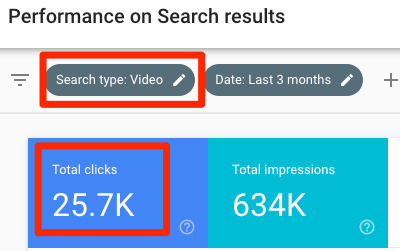
So how do you find the best pages to embed relevant videos? Easy. Go to the “Search Results” report in Google Search Console, click the “pages” tab, then sort the results by clicks from high to low. This shows the pages that received the most traffic from Google over the past few months.

DON’T USE SEARCH CONSOLE? Paste your domain into Ahrefs’ Site Explorer and go to the “Top Pages” report to see those with the most estimated traffic.

Look for pages where you have a relevant and useful video on a similar topic, then embed that video on the page when and where it makes sense. For example, our guide to YouTube tags is one of our top posts with around 2,400 search visits per month. But unfortunately, it doesn’t appear in Google’s “videos” tab because we don’t yet have a video about YouTube tags to embed in the post. However, we do have a related, helpful video about YouTube SEO, so we decided to embed that at the end of the post instead.

Shortly after doing this, our page appeared in the videos tab for the query, “YouTube tags”:

This has already sent a few clicks our way in just a few days.

2. Add schema markup for embedded videos Google sometimes shows video rich results for web pages with embedded videos.

Showing “video rich results” for the query, “Chicago weather.” However, Google says that pages aren’t eligible for this type of result unless the embedded video is marked up using the correct schema code: You must include the required VideoObject properties for your content to be eligible for display as a video rich result. From our observations, this isn’t strictly true. If your embedded video is hosted on YouTube, Google often shows a video rich result even in the absence of VideoObject schema markup. For instance, here’s a video rich result for a Medium post with an embedded YouTube video:

If we check that URL with Google’s Structured Data Testing tool, we see that there’s no VideoObject markup on the page.

That said, Google still recommends adding video markup for embedded videos, even if they’re hosted on YouTube. SIDENOTE. If you’re hosting videos on your own site, Google needs to see VideoObject markup before it considers them for video rich results. If you use WordPress, adding this markup is straightforward with a free plugin like Schema & Structured Data for WP & AMP. Once installed, hit Structured Data > Schema types on the menu.

Next, click the “Add Schema type” button.

Select “VideoObject” from the dropdown, then hit “Next” again.
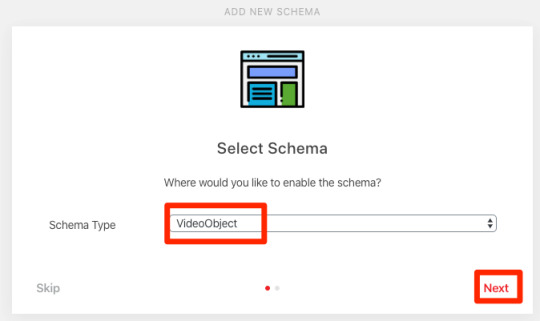
Click the “Post type” dropdown and change it to “Show globally.”

Hit “next” one final time, and you’re done. Now, whenever you’re editing a post or page, there should be an option to “Modify current schema” at the bottom of the editor.
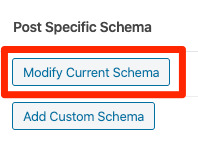
Click this, and you’ll see options to toggle VideoObject markup on or off, and to add attributes.

The attributes that Google says you must fill in are: Name; Description; Upload Date; Thumbnail Url All other fields can be left blank, although we recommend filling in useful attributes like duration. If you’re not using WordPress, watch this video and read the schema.org VideoObject documentation to learn how to add this manually. To verify that the markup was added correctly, use Google’s Structured Data Testing tool. 3. Add transcriptions to “thin” pages with embeds If you’re planning to embed a video on a web page with little or no text, consider publishing it alongside a written transcript. This is what Moz does with their Whiteboard Friday videos, and some of them get lots of traffic from Google.

SIDENOTE. Moz’s videos aren’t hosted on YouTube, but the point still stands. From a UX standpoint, this is a positive move because some visitors prefer reading over watching a video—and Google wants to rank content that appeals to as many searchers as possible. Just don’t paste and publish the transcript verbatim. Edit and format the copy as a blog post. Add subheadings and images to make the published transcript a good alternative for those who prefer text over video.
Final thoughts
Video SEO is a dynamic topic because Google is continually changing the way they display videos in the search results. That said, the two overarching “best practices” remain static: Create enticing and engaging videos for users; Do everything in your power to help Google better understand that content, to increase the chances of them showing your videos in web search results. https://ahrefs.com/blog/video-seo/ Read the full article
#videoseocompany#videoseofirestorm#videoseohouston#videoseomarketing#videoseomeaning#videoseophoenix#videoseoplugin#videoseoreports#videoseoln#videoseoulamp
0 notes
Text
Video SEO: How to Rank YouTube Videos on Google
Looking to get more YouTube video views from Google? Google has sent over 160,000 views to our YouTube videos in the last ~12 months.

That’s more views than the countless video embeds on our blog have sent us, which currently gets over 250,000 organic visits per month. In this post, you’ll learn how to rank your YouTube videos on Google in 5 easy steps. We’ve also included a few bonus tips on how to use videos to get more website traffic. But first, let’s make sure we’re on the same page…
What is video SEO?
Video SEO is the process of getting more video views from Google and utilizing videos to increase organic traffic to your website. In this guide, we’ll focus mainly on the first part: getting more views from Google. What we’re not going to talk about is ranking videos higher on YouTube. If that’s your goal, read our full guide to YouTube SEO.
How to rank YouTube videos on Google
Follow these five steps: Find topics with “traffic potential” Create an “optimized” video Fix the closed captions Upload an enticing thumbnail Add timestamps Let’s go through each of these in more detail. Step 1. Find video topics with “traffic potential” Not every video has the potential to attract views from Google. For instance, here’s a video with over 2.2 million views on YouTube:
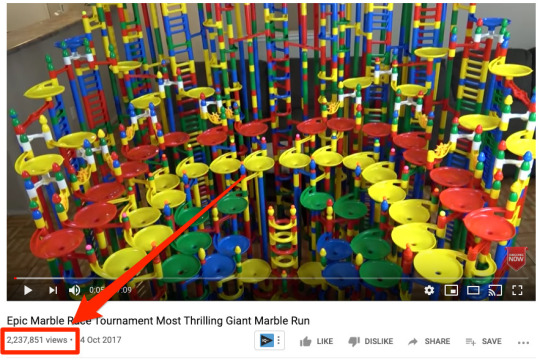
Yet it doesn’t rank on Google for anything:

The reason for this is simple: For a video to attract views from Google, two things have to be true: People need to be searching on Google for that topic. If nobody is searching for it, then nobody will click on your video even if it ranks. The topic must have “video intent.” This means that most searchers would prefer to watch a video about the subject instead of reading about it. Keyword research tools can help with finding topics that people are searching for. You can then look for videos in the search results to infer “video intent.”
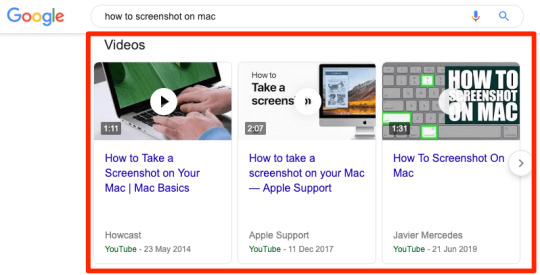
Example of a search query with video results in a carousel. The logic here is that because Google aims to give users what they want, seeing videos in the search results is a clear sign that searchers want to watch a video. The question is, how can you find these topics easily? Simple. Look for relevant videos that get lots of traffic from Google, as these are clearly about topics with “video intent” that lots of people are searching for. Here are three ways to do that: 1. Use Content Explorer Content Explorer lets you search a database of over 1.1 billion web pages for mentions of a particular word or phrase. Within that index, there are currently over 47 million pages from YouTube. To get started, run this search: site:youtube.com inurl:watch title:topic

Sort the results by search traffic from high to low. This should give you a list of relevant YouTube videos that currently get organic search traffic.
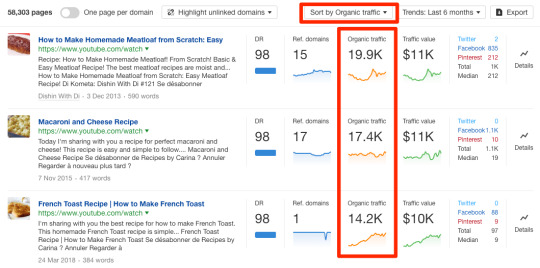
For example, the macaroni and cheese video above gets an estimated 17,400 clicks from organic search every month. If you had a cooking channel, it might be worth creating a video on this topic. QUICK TIP When looking for ideas in Content Explorer, it’s worth eyeballing the “Organic traffic” graph for the past six months to make sure that traffic is consistent over time.

2. Use Site Explorer Head to Site Explorer and search for youtube.com. Go to the “Organic keywords” report, then add a relevant keyword to the “Include” filter.
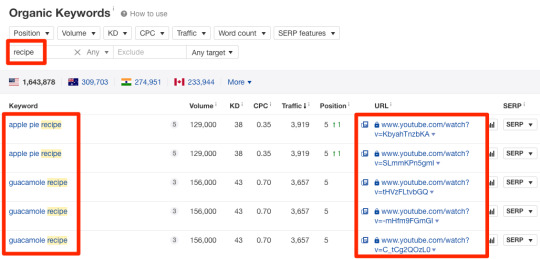
Here, we see YouTube videos ranking for queries that include the word “recipe.” If we click the caret next to any of these URLs, we see their estimated worldwide monthly organic traffic.
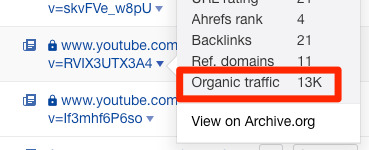
For example, this video gets ~13,000 monthly organic visits. If we click on the video URL, we see that it’s a Belgian waffle recipe, so this is another topic that may be worth covering on a cooking channel. QUICK TIP Before pursuing a topic, hit the “Overview” link on the caret and check the “Organic traffic” graph to make sure that it’s consistent over time. You want to see a graph like this…
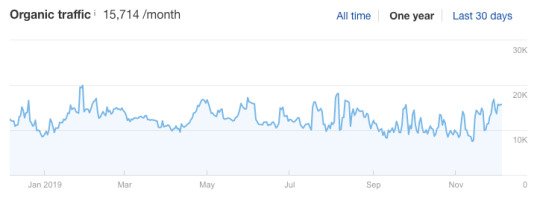
… not like this:
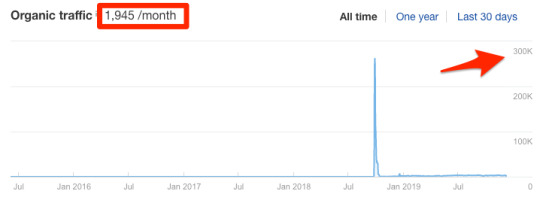
A big traffic spike followed by a small amount of traffic for a long period is a sign of a topic with waning interest. 3. Use Google and Ahrefs’ Batch Analysis tool Add this free SERP scraper to your browser, then run this search on Google: site:youtube.com Next, go to Settings > Search settings > then set the results per page to 100.
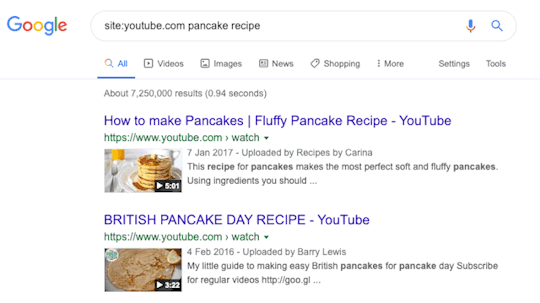
Go back to the results and hit the SERP scraper to download the results.
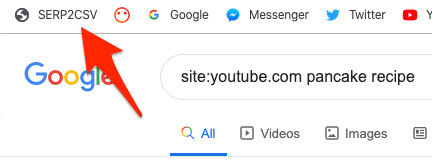
Open the downloaded CSV, then copy-paste the YouTube URLs into Ahrefs’ Batch Analysis tool. Set the mode to “URL” and hit “Analyze.”
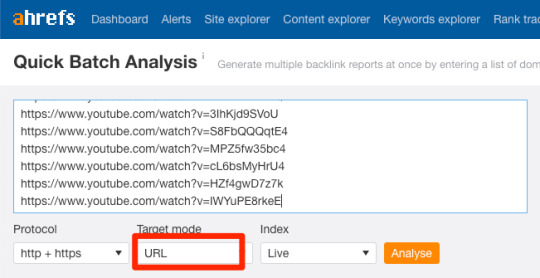
Sort the results by the “Traffic” column to see which videos get the most organic search traffic.
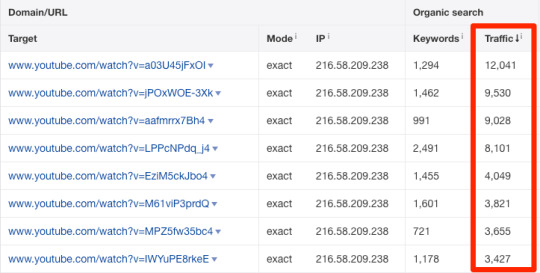
Consider making videos about these topics. Step 2. Create an “optimized” video Learning how to make YouTube videos that people love is beyond the scope of this guide. But we are going to cover a few things to keep in mind during the creation process that may help you rank in Google SERP features like “key moments” and “suggested clips.”
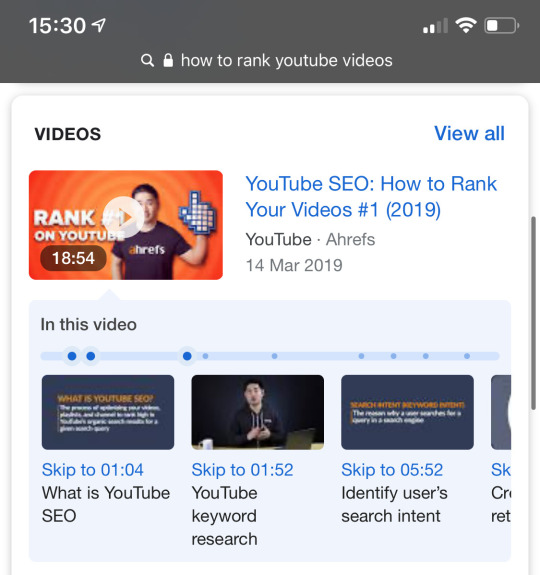
Key moment SERP feature in Google.
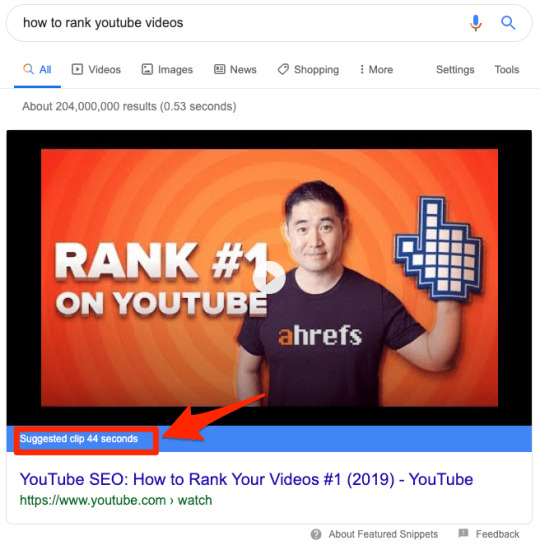
Suggested clip SERP feature in Google. Both of these have the potential to send more views to your videos. For now, let’s focus our attention on “suggested clips.” (We’ll cover “key moments” in step #5). Judging by Google’s research paper, the way suggested clips are chosen from a technical standpoint isn’t that straightforward. So instead of focusing on the technicalities, let’s focus on actionable steps to take that may you help win them. The first is to use simple language and “action verbs” to describe each step in the video. For example, if your video tells people how to cook rice, simple spoken instructions may be: To begin, wash the rice with cold water. Repeat this process three times, then tip the rice into a pan. Add fresh water, bring to a boil, cover, then simmer for 15–20 minutes. Drain the excess water and serve. Make sure to avoid unnecessary fluff and distractions between instructions where possible. In other words, don’t go off on a tangent explaining how your mom once deviated from one of the steps and ended up with burnt rice. This will only reduce clarity, which may confuse Google’s language processing algorithms. The second is to ensure that your audio is clear and high quality. To do this, use a decent microphone and keep background noise to a minimum. The third is to show what you’re talking about on the screen as you talk about it. For instance, if you tell people to “put the pan on the hob,” show footage of that process on screen as you do so. This may increase Google’s confidence that the spoken instructions align with the content of the video. Recommended reading: Video Featured Snippets: How Suggested Clips Work Step 3. Fix your closed captions YouTube automatically adds closed captions to videos. The problem is that these are rarely perfect. Misspelled words and grammatical errors are a common issue. Just take a look at these auto-generated captions from one of our old YouTube videos:

YouTube thinks Tim is saying “team solo from a traps” when he’s actually saying “Tim Soulo from Ahrefs.” For that reason, it’s best to add your own. Here’s what one of the videos on YouTube’s Creator Academy says about CC’s: In terms of search, discovery, and engagement, captions are one of the most powerful pieces of data out there. The internet is text-based, so your video is going to stay hidden from search engines unless the text attached to it can be picked up. It can be hard to get across the essence of your video in just a title or description, even tags have a character limit. But a closed-caption file delivers a text-based transcript of your entire video and opens it up to search engines. That same video goes on to say: Text on screen has proven to be so engaging that it increases the watch to completion rate. These two factors lead to a monumental gain in SEO ranking and engagement. Given these quotes, it seems that adding CC’s helps with two main things: Understanding your video. Google won’t rank your video without understanding what it’s about, and closed captions appear to help with that. Engagement. Lots of people watch videos in noisy or sound-sensitive environments, and over 5% of the world’s population has hearing loss of some degree. Closed captions help ensure that your video is useful to more people. That improves engagement, which, in turn, may lead to higher rankings in Google. It’s also worth noting that if you’ve scripted your video, it doesn’t take long to fix closed captions manually, so it’s well worth doing. Step 4. Upload an enticing thumbnail Videos with poor thumbnails won’t get as many clicks from Google as those with enticing ones. Here’s an example of a lousy thumbnail in a video carousel for the query, “how to make pancakes”:
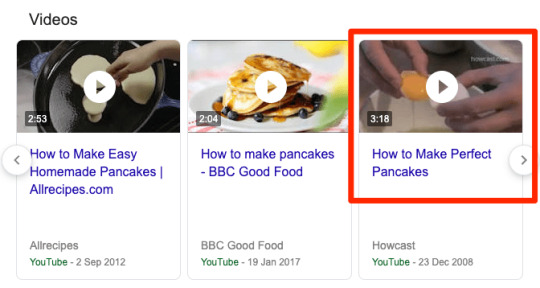
Not only is this visually dull and uninspiring, but the thumbnail shows an egg, not pancakes. Here are a few tips for creating thumbnails that entice searchers to click: Use a custom thumbnail Don’t choose a still from your video. Create a custom and enticing thumbnail to grab the searcher’s attention. Use the correct aspect ratio Google shows video thumbnails in the 16:9 format. As a result, those with other aspect ratios can look odd in the search results, and that may dissuade the click.
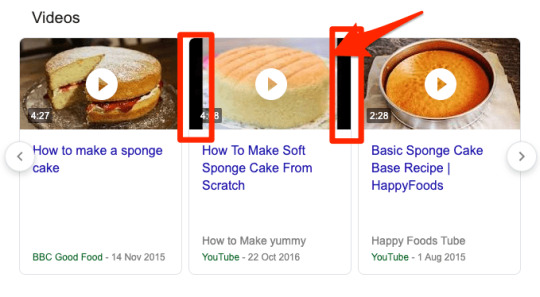
Use a congruent image Create a thumbnail that visually demonstrates that the video solves the user’s query. For example, if someone searches for “how to tie a tie,” then this thumbnail makes sense because it shows someone tying a tie:

On the other hand, this one doesn’t make much because you can barely tell that the kid is wearing one:

Use contrast to your advantage Avoid colors like white, grey, and red on your thumbnail as they blend in with search results. Instead, use contrasting colors that stand out. We tend to use dark blue and orange.
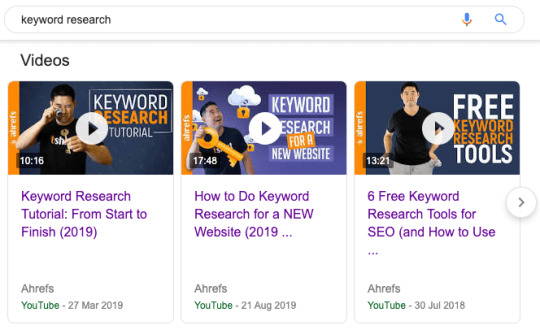
Use descriptive text on the thumbnail This is something we do for all of our YouTube videos. For example, our video about learning SEO has the words “Learn SEO” on the thumbnail.
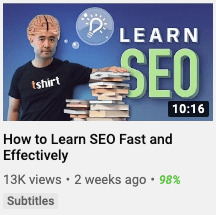
Usually, we go for something short that compliments the title of the video. Whatever text you use, make sure that it’s written in an easy-to-read font, and looks good at both small and large sizes. Step 5. Add timestamps Earlier, we briefly mentioned the “key moments” that Google sometimes shows in search results.
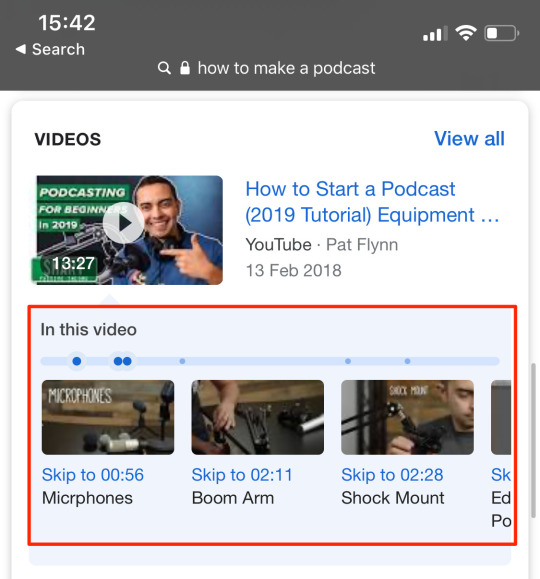
Here’s what Google says about these: When you search for things like how-to videos that have multiple steps, or long videos like speeches or a documentary, Search will provide links to key moments within the video You’ll be able to easily scan to see whether a video has what you’re looking for, and find the relevant section of the content. Google also says: If your video is hosted on YouTube, Google Search may automatically enable clips for your video based on the video description on YouTube, and you may not have to mark specific timestamps in your YouTube description. However, you can tell us more explicitly about the important points in your video and we will prefer that information. Long story short, Google is probably more likely to show “key moments” for your videos if you mark important points in the YouTube description. To do that, use timestamps and labels. What’s a timestamp? This is when a clip starts in the :: format. You can negate the if it’s not needed. Video timestamps are automatically linked. What is a label? This is a brief and clear description of the clip. You can see an example of timestamps and labels on our video about YouTube SEO.
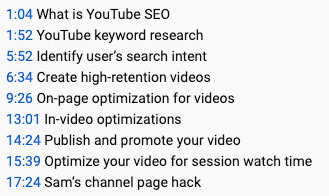
These nine timestamps take viewers to sections of the video about what YouTube SEO is, YouTube keyword research, identifying search intent, and so forth. Seemingly thanks to these optimizations, Google now shows “key moments” for our video for the query, “how to rank YouTube videos.”

The same is true for our video about link building with Google sheets.
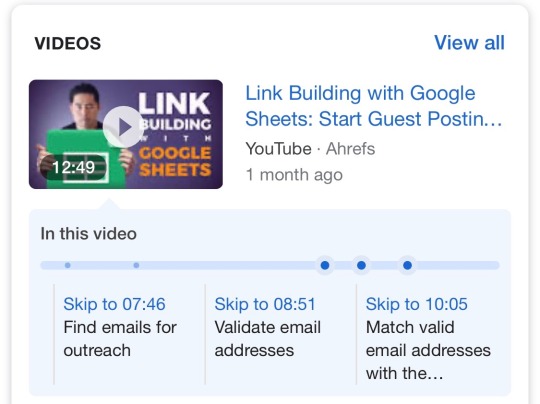
Here are some tips for adding timestamps and labels: Add timestamps to the video description. Don’t place it in a pinned comment. Place each timestamp on a new line. Specify the label on the same line. Keep the label brief but descriptive. Your label should be a direct statement of what the section is about (e.g., “Boil the pasta” not “Put your pasta in the pan and cook it for 10–15 minutes until al dente”) List timestamps in chronological order. Don’t add a timestamp for something at the end of your video before earlier points. Keep labels to around 40 characters or less. Google truncates longer ones. Don’t add too many timestamps. Google hasn’t mentioned a maximum or a minimum number of timestamps they’ll show in search results. However, it’s unlikely that they’ll show a carousel with hundreds of them. As a general rule of thumb, we’d recommend no more than ten timestamps per video. Align the on-screen content with the label. If your label says “Chop the onion,” try to add the timestamp when you’re visibly chopping the onion on the screen. Note that “key moment” results are only available for YouTube videos at present, so this isn’t something that works for videos hosted elsewhere. However, Google has said they’re planning to introduce support for other videos soon. We’re also introducing a way for more content creators across the web to mark up their videos so they can be more easily searchable. Soon you’ll be able to find these key moments from video publishers around the world, such as CBS Sports and NDTV, as they add markup to their videos
Bonus tips: How to use videos to get more website traffic
Video SEO is not only about getting more YouTube video views from Google. It also involves utilizing videos to attract more traffic to your website from organic search. Below are three tips to help with that. 1. Embed relevant videos on top-ranking pages Google has a “Videos” tab, where there are two types of results: Relevant YouTube videos; Pages from the organic results with relevant video embeds That second one is important. It means that if you’re ranking high in Google already, you can get those pages to show up in Google’s “Videos” tab by embedding a relevant video. When someone clicks one of these results, Google sends them to your website—not YouTube.
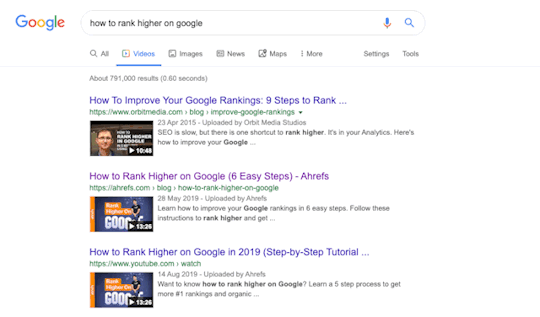
In fact, video embeds have sent over 25,000 visits to our blog from Google over the past three months:
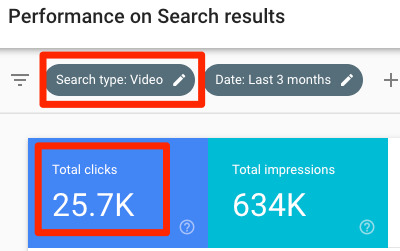
So how do you find the best pages to embed relevant videos? Easy. Go to the “Search Results” report in Google Search Console, click the “pages” tab, then sort the results by clicks from high to low. This shows the pages that received the most traffic from Google over the past few months.
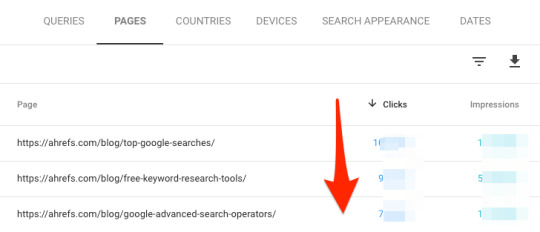
DON’T USE SEARCH CONSOLE? Paste your domain into Ahrefs’ Site Explorer and go to the “Top Pages” report to see those with the most estimated traffic.
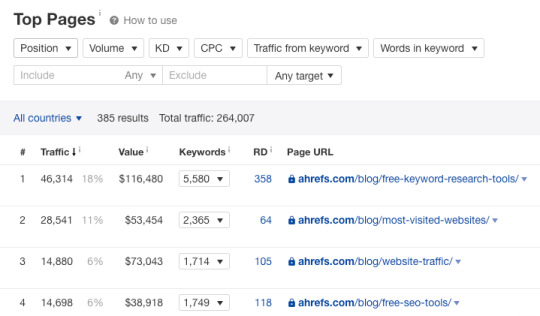
Look for pages where you have a relevant and useful video on a similar topic, then embed that video on the page when and where it makes sense. For example, our guide to YouTube tags is one of our top posts with around 2,400 search visits per month. But unfortunately, it doesn’t appear in Google’s “videos” tab because we don’t yet have a video about YouTube tags to embed in the post. However, we do have a related, helpful video about YouTube SEO, so we decided to embed that at the end of the post instead.
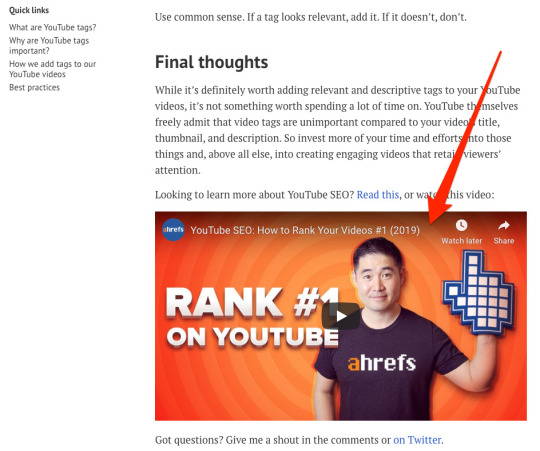
Shortly after doing this, our page appeared in the videos tab for the query, “YouTube tags”:

This has already sent a few clicks our way in just a few days.
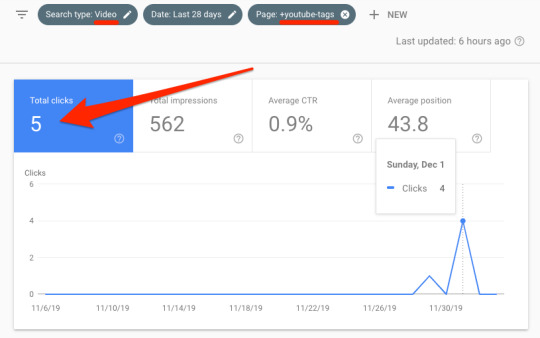
2. Add schema markup for embedded videos Google sometimes shows video rich results for web pages with embedded videos.
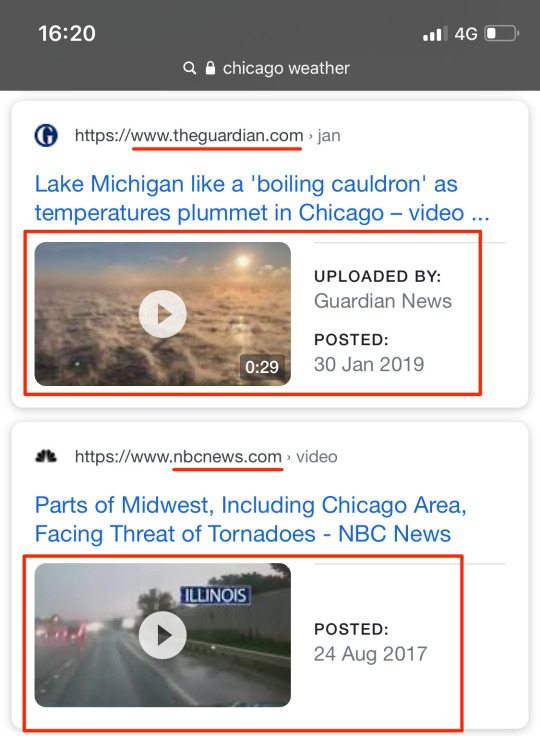
Showing “video rich results” for the query, “Chicago weather.” However, Google says that pages aren’t eligible for this type of result unless the embedded video is marked up using the correct schema code: You must include the required VideoObject properties for your content to be eligible for display as a video rich result. From our observations, this isn’t strictly true. If your embedded video is hosted on YouTube, Google often shows a video rich result even in the absence of VideoObject schema markup. For instance, here’s a video rich result for a Medium post with an embedded YouTube video:

If we check that URL with Google’s Structured Data Testing tool, we see that there’s no VideoObject markup on the page.
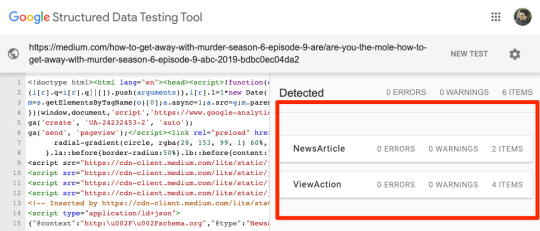
That said, Google still recommends adding video markup for embedded videos, even if they’re hosted on YouTube. SIDENOTE. If you’re hosting videos on your own site, Google needs to see VideoObject markup before it considers them for video rich results. If you use WordPress, adding this markup is straightforward with a free plugin like Schema & Structured Data for WP & AMP. Once installed, hit Structured Data > Schema types on the menu.
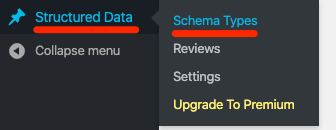
Next, click the “Add Schema type” button.

Select “VideoObject” from the dropdown, then hit “Next” again.
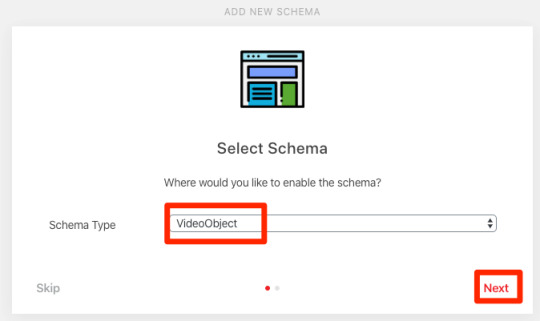
Click the “Post type” dropdown and change it to “Show globally.”

Hit “next” one final time, and you’re done. Now, whenever you’re editing a post or page, there should be an option to “Modify current schema” at the bottom of the editor.
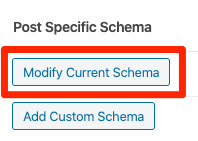
Click this, and you’ll see options to toggle VideoObject markup on or off, and to add attributes.
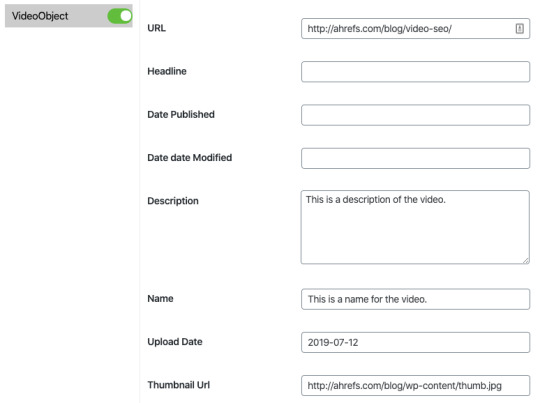
The attributes that Google says you must fill in are: Name; Description; Upload Date; Thumbnail Url All other fields can be left blank, although we recommend filling in useful attributes like duration. If you’re not using WordPress, watch this video and read the schema.org VideoObject documentation to learn how to add this manually. To verify that the markup was added correctly, use Google’s Structured Data Testing tool. 3. Add transcriptions to “thin” pages with embeds If you’re planning to embed a video on a web page with little or no text, consider publishing it alongside a written transcript. This is what Moz does with their Whiteboard Friday videos, and some of them get lots of traffic from Google.

SIDENOTE. Moz’s videos aren’t hosted on YouTube, but the point still stands. From a UX standpoint, this is a positive move because some visitors prefer reading over watching a video—and Google wants to rank content that appeals to as many searchers as possible. Just don’t paste and publish the transcript verbatim. Edit and format the copy as a blog post. Add subheadings and images to make the published transcript a good alternative for those who prefer text over video.
Final thoughts
Video SEO is a dynamic topic because Google is continually changing the way they display videos in the search results. That said, the two overarching “best practices” remain static: Create enticing and engaging videos for users; Do everything in your power to help Google better understand that content, to increase the chances of them showing your videos in web search results. https://ahrefs.com/blog/video-seo/ Read the full article
#videoseocompany#videoseofirestorm#videoseohouston#videoseomarketing#videoseomeaning#videoseophoenix#videoseoplugin#videoseoreports#videoseoln#videoseoulamp
0 notes
Text
7 Successful Amazon Affiliate Websites (That You Can Learn From)

Heard a lot about Amazon affiliate websites but have no idea where to start? Take inspiration from these seven examples. Amazon affiliate websites make money via commissions from their affiliate program: Amazon Associates. Here’s how this works: A person visits an Amazon affiliate site. They click on an affiliate link to buy a recommended product on Amazon. Amazon pays the site owner a commission. In this post, we’ll share some inspiring Amazon affiliate websites, why they’ve done so well, and how you can replicate their success. Let’s get things started.
1. The Prepared

Key stats Domain Rating: 36 Number of referring domains: 901 Number of keywords it ranks for: 40,600 Estimated organic traffic: 31,900 Site age: 2 years Estimated revenue: Unknown Founded by John Ramey and John Adama—former advisors at the Obama White House—The Prepared is a survivalism website that publishes practical guides on preparing for emergencies ranging from potential car accidents to war. Why they’re doing so well For starters, the doomsday prepper market is huge. According to Finder.com, an estimated 160+ million Americans have either recently purchased survival gear or are already in possession of some. Of course, The Prepared is not the only website focused on survivalism. There are tons of websites in this niche. The success of this particular site falls largely down to its owners’ focus on creating content about evergreen topics. Evergreen topics are those with consistent interest and search volume over time. For example, we can see that The Prepared targets keywords like “best tarp.”
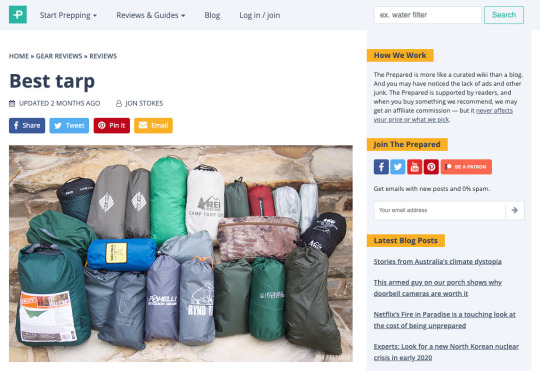
According to Google Trends, this is a topic with increasing interest over time:
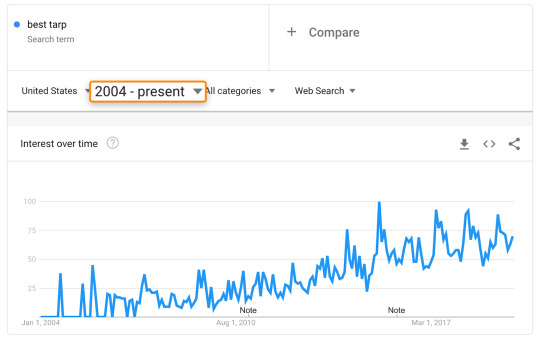
They’re also committed to updating their content regularly to keep it evergreen. After all, a list of the best tarps won’t stay fresh forever since new products are released all the time.
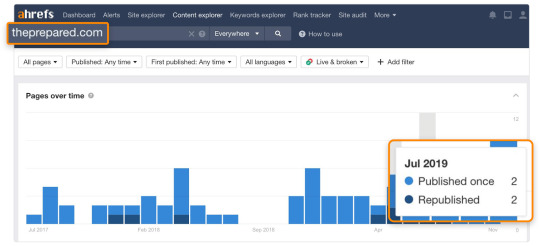
If they update something, they’ll mention what changed in the post:

The benefits of this approach are obvious: They don’t have to worry about waning interest in their topics. People will still be searching for “best tarp” 5 years from now. They can get consistent organic traffic over time. Google tends to favor fresh results for queries like “best tarp” because old posts are out of date and no use to searchers in 2020. By publishing regular, minor updates as new products become available, the guys behind The Prepared can maintain rankings long term. What also makes them stand out is the quality of their content. For their reviews, they test every product before publishing, and they’re transparent about the testing process.
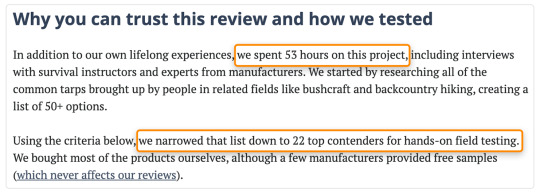
Essentially, this is the Wirecutter model (we’ll talk more about them later!). The Prepared simply took the idea and focused on a single niche. How to replicate their success Focus on creating “best ” posts for evergreen product categories. These are things that people will still be looking to buy in years to come. For example, a list of the best dishwashers has longevity since there are always people in the market for a new appliance. That’s why Google Trends shows consistent search demand over time.
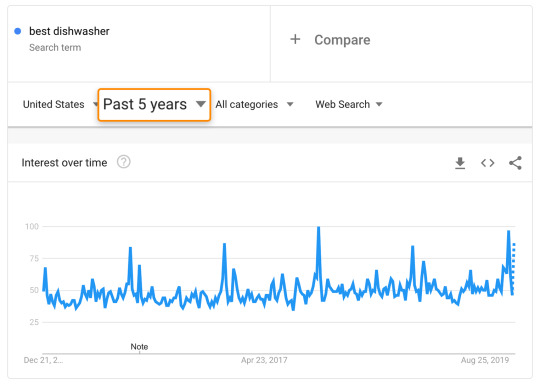
Of course, some topics are seasonal such as “best tents.”

This isn’t an issue because its popularity is consistent year over year. You’ll just experience more sales during certain parts of the year. What you want to avoid are non-evergreen topics with waning interest, like “best fidget spinner.”

The benefit of creating content about evergreen product categories is that it has the potential to attract organic traffic long term. Just make sure your SEO strategy is sound and you keep the posts updated. Learn more about how to do this in our guide to evergreen content.
2. Homegrounds

Key stats Domain Rating: 63 Number of referring domains: 1,320 Number of keywords it ranks for: 136,000 Estimated organic traffic: 244,000 Site age: 3 years Estimated revenue: Unknown Homegrounds is a site that teaches “home baristas” how to brew and enjoy better quality coffee. Why they’re doing so well I reached out to the site’s founder, Alex Azoury, to find out. Here’s what he said: Firstly, we commit to publishing content that is better than our competitors. This is because the coffee brewing market are switched on, and they definitely appreciate content that actually solves their problem, rather than content built to simply target a keyword. Secondly, we reverse engineer our competitors via Ahrefs’ Site Explorer to uncover content and backlink opportunities that are working for them. If it works for them, it will most likely work for us. Finally, we dig deeper into keywords and think about search intent, rather than just looking at search volume. The topics that eventually perform the best from a financial perspective are rarely the ones that look the best on face value. Again, Ahrefs’ Keywords Explorer has been an invaluable resource for this.

Alex Azoury, Founder & Editor How to replicate their success If we distill what Alex said above, we see that what worked for the Homegrounds team is to focus on the basics: Do keyword research and find topics with traffic potential. Create content that aligns with search intent and trumps everything else on quality. Build links to the content by replicating competitors’ link building strategies. Learn how to do this in our guide to ranking on the first page of Google.
3. Dog Food Advisor

Key stats Domain Rating: 76 Number of referring domains: 5,890 Number of keywords it ranks for: 203,000 Estimated organic traffic: 594,000 Site age: 11 years Estimated revenue: Unknown DogFoodAdvisor is a site that helps pet owners make better decisions when buying dog food. Why they’re doing so well The pets market is enormous. It’s estimated that $75 billion was spent by pet owners in 2019, with $31 billion on pet food alone. And therein lies the key to this site’s success. Instead of writing broadly on pets or even pet food, they chose to focus solely on dog food. It also helps that the keyword “dog food” has a global search volume of 117,000 searches per month.
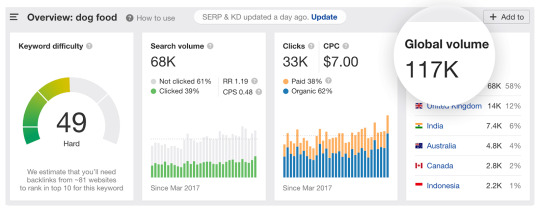
This focus helped them to stand out in a saturated niche, and almost certainly also helped them to rank for thousands of dog food-related keywords.
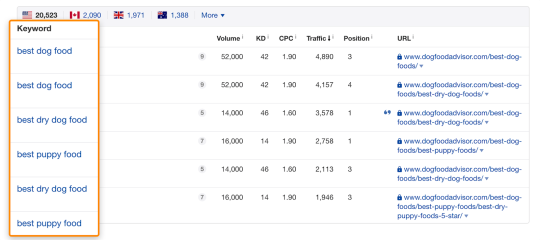
How to replicate their success There are plenty of things to emulate, but lets drill down on two aspects: 1. Create content hubs Their page on the “best dog foods” ranks for over 1,300 keywords, sending them an estimated ~20,284 US search visits per month.
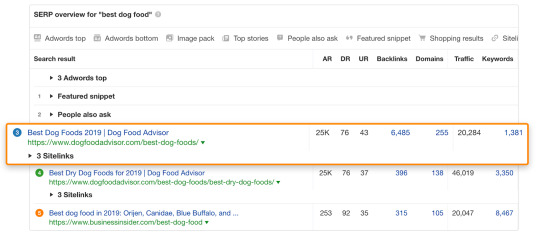
Given that there are so many types of dog foods available for different breeds and for various purposes, it would be impossible to answer the question of “what is the best dog food” in a single article. Instead, what this page does is internally link to more specialized articles on the subject, allowing readers to choose the one that applies most to them. This is known as a “content hub.”
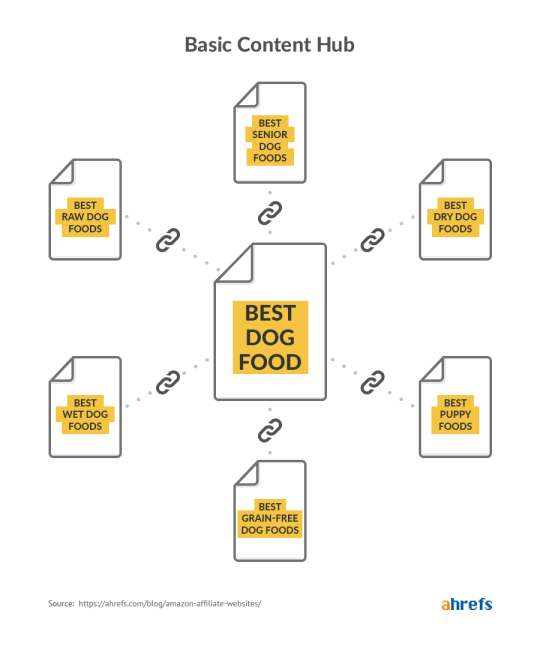
Besides creating a better user experience, “hub” pages are also beneficial for SEO. This is because more “authority” is transferred to DogFoodAdvisor’s most important pages as subpages link back to hub pages and vice-versa). This is almost certainly part of the reason why this page is ranking so well. Learn more about the types of content hubs in this post. 2. Create useful content that attracts links Dog food recalls are surprisingly common but also easy to miss. DogFoodAdvisor solves this problem with their up-to-date list of dog food recalls.
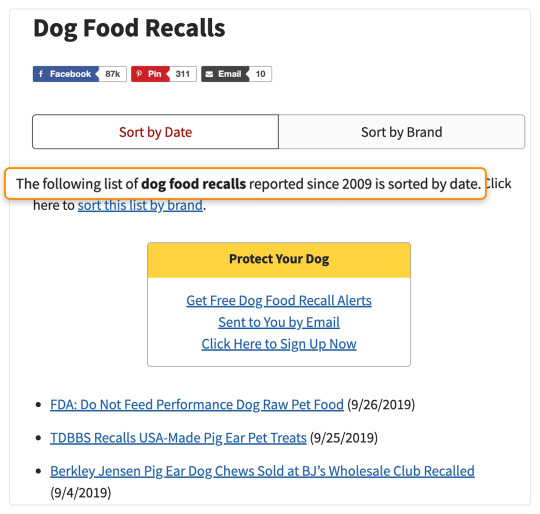
To date, this page has links from 390 websites.
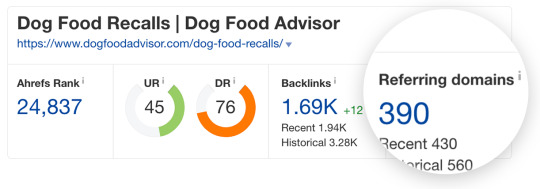
Takeaway: Don’t focus solely on “best ” keywords. Create useful, informational content that attracts links and boosts your authority. Learn more about how to create content that attracts links.
4. PCPartPicker
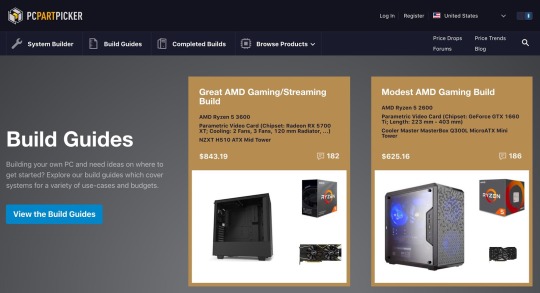
Key stats Domain Rating: 74 Number of referring domains: 8,810 Number of keywords it ranks for: 785,000 Estimated organic traffic: 3,100,000 Site age: 9 years Estimated revenue: Unknown Many people want to build their own PC, but the process isn’t that straightforward—particularly for newbies. This is where PCPartPicker excels. Choose the parts you want for your PC, and PCPartPicker will provide compatibility guidance and up-to-date pricing. They also publish “build guides” for those who are unsure how to start building one. Why they’re doing so well PCPartPicker is interesting because it deviates from the traditional affiliate model of targeting “best ” keywords. Instead, it’s a tool. Knowing which components to buy is a big problem in the “build your own PC” world. PCPartPicker solves this by letting you shop for the latest PC parts based on performance and budget. It then automatically cross-references them to check for compatibility. Then, based on what you’ve configured, you can purchase directly from Amazon (with PCPartPicker’s affiliate links.)
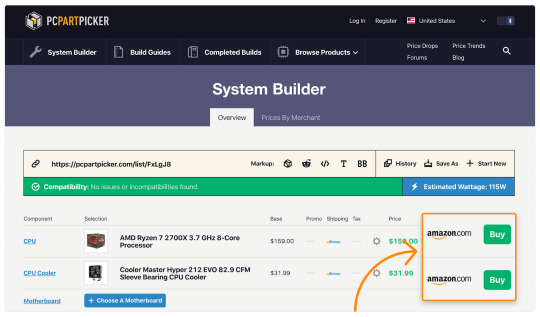
The most remarkable part about this is how much trust the site has built with its audience. A big issue with affiliate sites is they often recommend products based on the highest commissions. This “strategy” quickly erodes trust, causing many affiliate sites to fail. But PCPartPicker’s tool is unbiased. It doesn’t push any particular products. All it does is allow users to choose their own configurations, and then make commissions off those choices. Because the tool is so useful, it markets itself via word-of-mouth.
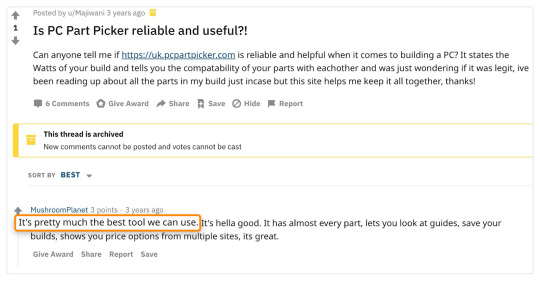
Along the way, the tool page itself has picked up 835 referring domains—many of which come from authoritative, high-DR sites like The Verge, PC World, etc.

How to replicate their success Not all Amazon affiliate websites must be “content sites” to do well. There are other ways to excel. Is there a big problem in your niche? Can you build a free tool or resource to help fix that problem and potentially make some affiliate income along the way? Sometimes, you have to think outside the box. Learn more about how to find these opportunities in this guide (skip to example #4)
5. Equipboard

Key stats Domain Rating: 58 Number of referring domains: 2,560 Number of keywords it ranks for: 722,000 Estimated organic traffic: 354,000 Site age: 5 years Estimated revenue: Unknown Equipboard is a site that showcases the gear, tools, and products used by famous musicians. Content on the site is partially user-generated. The founders (Giulio and Michael) review products and create content targeting “best” keywords, and users contribute content about the gear their favorite artists use. Why are they doing so well? As an affiliate site, Equipboard targets “best” keywords in their niche. That’s to be expected. But they also tackle the affiliate model from a unique angle. A big part of their site is the breakdown of the gear and tools that famous musicians use. That’s pretty smart. In the music world, people want to be more like their idols. They want to play the guitar like Slash, rap like Eminem, or sing like Ariana Grande. Not only that, they want to use the same gear as these people. In fact, Giulio, the co-founder, says this is how Equipboard started. As musicians ourselves, we understand how musicians search for a certain sound and shop for gear. That led us to create a site around the way people explore gear, specifically by looking up to the pro musicians they admire.

Giulio Chiarenza, Co-founder This is also where Equipboard takes it to the next level. Think about it: there are thousands of musicians from every possible genre. It would take them forever to cover every single one of them. The solution? Enlist the help of their audience. On Equipboard, anyone can add content related to their favorite artists’ gear. Then, with the help of a few community moderators, the founders fact-check sources and ensure the suggestions are accurate. This allows them to scale content production at a relatively low cost. It also helps them to: Get traffic. Most of these musicians are famous, so there’s plenty of search volume for relevant terms (e.g. “jimmy page gear”.) Get affiliate link clicks. Since fans are already interested in the gear of their favorite musicians, it is likely they will click on their affiliate links. Get backlinks. Since they’re the most credible source for musicians’ tools and gear, they get tons of links from Wikipedia and other reputable sites. How to replicate their success Equipboard’s key to success is their unique selling point (USP): the breakdown of tools and instruments that famous musicians use. But here’s the cool part: you can apply this same concept to other niches. Run a golf site? There are plenty of people searching for what’s in the bags of famous golfers.
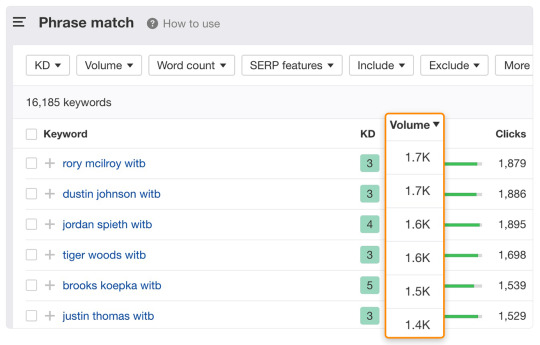
Run a book review site? People want to know what books famous people recommend.
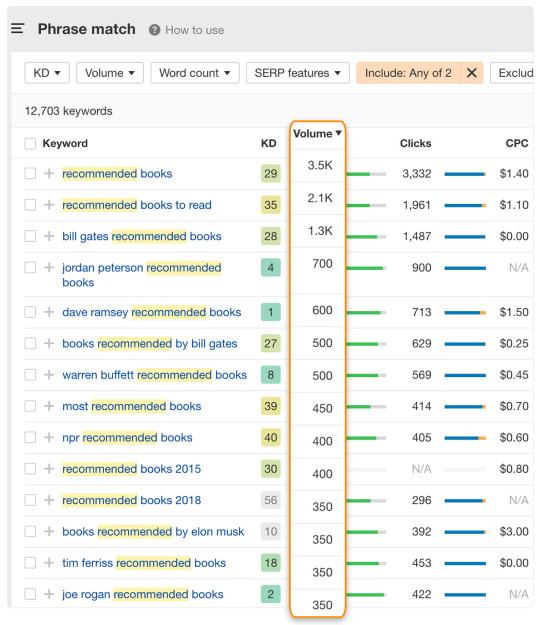
The examples are endless. You just need to find them, which is where a keyword research tool like Ahrefs’ Keywords Explorer (pictured above) comes in handy.
6. Territory Supply
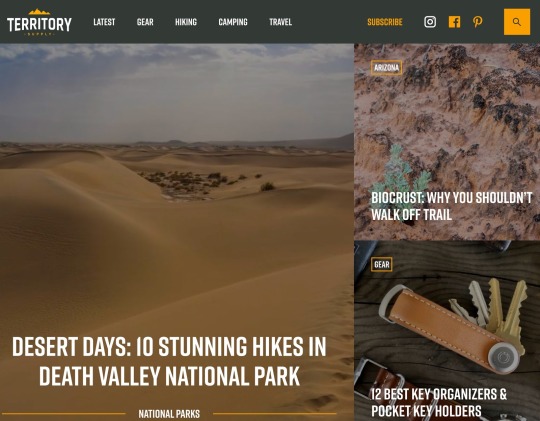
Key stats Domain Rating: 26 Number of referring domains: 275 Number of keywords it ranks for: 27,700 Estimated organic traffic: 26,600 Site age: 4 years Estimated revenue: ~4‑figures per month Territory Supply helps people find hiking, camping, backpacking, and travel adventures in the US, while also showcasing the best outdoor gear they should use. Why they’re doing so well The first thing you’ll notice when you visit Territory Supply is how much it looks like an online magazine, rather than a typical affiliate site. And indeed, they do run their site like a magazine. As an affiliate site, they have articles targeting “best x” keywords. But they also cover plenty of other topics that don’t link to any products. They’re also committed to linking to the best products, even if they can’t make money from their recommendations. For example, their post on “DIY teardrop camper kits” generates an estimated 1,800 search visits per month, but has only one link to an affiliate product.

Dustin Christiensen, the founder, reaffirms my thoughts. I think one reason we’ve had success with Territory Supply is that we’ve tried to provide more value than your average affiliate site. For example, a lot of our product recommendations come from small brands or retailers that don’t have an affiliate program whatsoever. But, those brands make some of the best products, so we’ve included them in our content because that’s what’s most valuable to our readers. We don’t just find five Amazon products and call it a day—we’ll put a lot of research into each product category to find unique products and brands that no one else is discussing since most sites can’t make money off of them. Secondly, we’ve invested heavily in our brand and appearance. Instead of putting up a cheap WordPress theme, I spent thousands of dollars on a custom designed website with some unique outdoor aesthetics that work well for the outdoor community. We tried to build something that didn’t look like a cheap, thin affiliate site and instead, wanted something that looked trustworthy, valuable and impactful. Last, we also do a lot of content that isn’t related to products or affiliate marketing at all — like hiking and camping guides that include the best locations to explore in different areas. These articles are research-intensive and we try to find writers who live in or explore the areas we write about so that they have real, accurate value for our readers. We do so much more than just product-based content that I think it helps find an audience that a lot of affiliate sites might miss out on.

Dustin Christiensen, Founder How to replicate their success Not every Territory Supply reader is ready to buy. Sometimes, they’re just curious. And when they read articles like “10 Stunning Hikes in Death Valley National Park”, they might be inspired to start exploring the outdoors more often. Or they might even be fired up to start hiking on the coming weekend. This will lead them to wonder about the gear they’ll need for hiking, which Territory Supply also helps with. The takeaway: just because you run an affiliate site doesn’t mean you should only cover “best” or “review” topics. You should target topics at every stage of the marketing funnel. Learn how to do this in our guide to finding and mapping keywords to the buyer’s journey.
7. The Wirecutter

Key stats Domain Rating: 82 Number of referring domains: 23,100 Number of keywords it ranks for: 3,700,000 Estimated organic traffic: 4,100,000 Site age: 8 years Estimated revenue: ~$10 million (2016) Founded in 2011 by Brian Lam, a former Editorial Director at Gizmodo, The Wirecutter has grown into perhaps the most famous and well-known Amazon affiliate site on the planet. Frustrated with the never-ending chase for pageviews in traditional media companies, Brian quit Gizmodo and started The Wirecutter as a small review site focused on gadgets. It was acquired by the New York Times in 2016 for $30 million. Why they’re doing so well Short story: they rank on the first page for 62,000+ “best” keywords in the U.S. alone:

The longer story: they’re the absolute champion of product reviews. When it comes to “best ” type posts, most affiliate sites simply curate whatever’s currently selling well on Amazon. Not The Wirecutter. For every category, they’ll thoroughly sample and test every major product. Where needed, they’ll hire professional reviewers.

They’re also transparent about how they test the quality of those products. Further, to prevent bias, the staff writers are not informed about what commissions the site receives for different products. And that’s not all. The Wirecutter understands that not everyone wants to read a lengthy review. They just want a reliable and trustworthy source to tell them which product to buy. So, in the first paragraph of every post, they get straight to the point. They build your trust by telling you how they researched it, then telling you exactly what to buy.
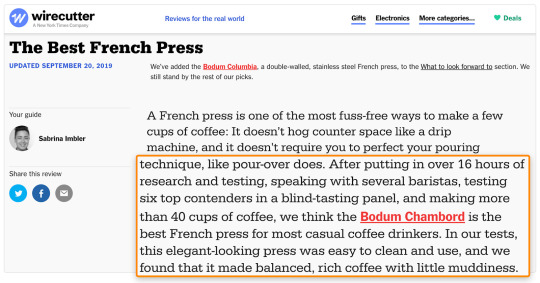
For the impatient, this is perfect. They can click through immediately and make the purchase. But even if they don’t buy right away, it’s okay. For Amazon affiliate sites, the click itself is important. After all, Amazon has a 24-hour cookie, which means that the site owner will receive commission on anything the person buys in the next 24 hours. That said, The Wirecutter doesn’t just cater to the impulse buyer. For those who are obsessed with researching every aspect of a purchase, there’s plenty of research to read.

How to replicate their success Focus on creating thorough, well-researched posts for “best ” type keywords in your industry. That means testing the products yourself where possible, and potentially even coming up with innovative ways to do so. If you’re starting out and can’t afford to purchase every product in the category, focus on delivering in-depth research. Not only does this approach build trust with readers and entice affiliate link clicks, but it also helps to attract backlinks.
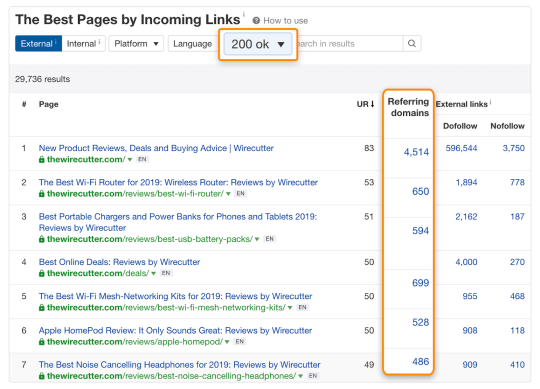
That said, while the quality of content certainly plays an important role here, we also suspect that employing an inhouse SEO team doesn’t hurt matters.

And that brings us to a crucial point: You shouldn’t try to replicate this model like for like on a site that reviews everything under the sun. Niche down and do things on a smaller scale. Coming full circle, that’s what The Prepared did in the preppers niche—and it worked out pretty well for them.
Final thoughts
Most successful Amazon affiliate sites follow roughly the same formula: They target commercial investigation keywords like “best ”; They create best-in-class content by actually reviewing products; They work hard to build and attract backlinks to improve rankings. None of this is rocket science. It just takes hard work, persistence, patience, and a focus on long-term over short-term results. Read the full article
#amazonaffiliateaccount#amazonaffiliatecommission#amazonaffiliateindia#amazonaffiliatelinks#amazonaffiliatelogin#amazonaffiliatemarketing#amazonaffiliatemarketingprogram#amazonaffiliateprogram#amazonaffiliateprogramrequirements#amazonaffiliateprogramsignin
0 notes
Text
Keyword research basics

WHAT is keyword research? Keyword research is an SEO practice of finding, analyzing and using the phrases people use to search for information on the internet. In other words, it is about getting to know the language of your potential visitors and using this knowledge to optimize your content. WHY to do keyword research? Because it is one of the most important SEO tasks and a great way to reach more people with your content. HOW to do keyword research? Well, this is something this guide will help you with. You don’t have to worry, keyword research isn’t rocket science. Once you understand the basics and learn some proven strategies (as well as some useful tips & tricks), you’re good to go! 😉 WHEN to do keyword research? Keyword research is usually the first step of search engine optimization of any website. Most often, it is needed when you’re: looking for a new niche looking for new content ideas optimizing your existing content WHO should do keyword research? Any website owner, blogger, online marketer or SEO specialist.
A very brief history of keyword research
The way people do keyword research has evolved over time. In the 2000s, keyword research was often reduced to visiting Google Keyword Planner, finding keywords with the highest search volume and stuffing them into the website text. What is a keyword? Keyword is any word or phrase that a user types into the search engine to find certain information on the internet. As many misused it, Google responded with several algorithm updates over the years. The goal of these updates was to understand what the users want and serve them with the best possible results. The most important algorithm updates that influenced the way we do keyword research: Google Panda – has penalized thin, low-quality content and duplicate text Google Penguin – has penalized unnatural usage of keywords Google Hummingbird – has improved semantic search and focus on search intent

Today, keyword research is much more than finding the “right” keywords and putting them into “right” places. Google is becoming better and better at understanding what people look for. Its main goal is to offer the content that satisfies their needs the best. Google RankBrain RankBrain is a component of Google’s algorithm based on artificial intelligence. It had been around for a couple of years, but it took some time until it was fully implemented. In 2015, Google announced that RankBrain is the third most important ranking signal. Thanks to RankBrain, Google understands 2 things: How users interact with the organic search results What is the search intent behind the query In other words, keyword research is becoming more and more topical. It is no longer about finding one ideal keyword. It is about understanding the audience and covering the topic in a complex way. To put it simply – if the topic is well-covered, you can rank for keywords you did not even use in the text! You don’t believe me? Find out yourself! This doesn’t mean that keyword research is no longer important – quite the contrary. It just looks a little different than in the past.
Stages of keyword research
For the purpose of this guide, I have divided the whole process into 3 main steps: Finding the keywords Analyzing the keywords Using the keywords

Let’s dive into the details of each step.

Chapter 2
How to find keywords
In order to write compelling content that covers the needs of people interested in your niche, you need to know what they are looking for. My first keyword research advice would be: Know your niche! Keyword research allows you to have a deeper understanding of the sub-topics and recurring themes in your niche. In this chapter, I’ll cover the following tools and platforms where you can find keywords: Google Keyword Planner | Keyword tools | Google suggestions | AnswerThePublic | YouTube | Google Search Console | Reddit | Quora | Forums | Amazon | Feedly (click to jump to the specific part) Let’s say you have a blog about hiking. You don’t need to be a genius to know that one of the keywords you want to rank for is “hiking” or “hiking trails”. The issue with these keywords (sometimes called short-tail keywords, although the name doesn’t really make sense) is that they naturally have very high competition. But if you dig deeper into the niche, you’ll find that people interested in hiking may also use keywords like: “GPS watch with heart rate monitor” “best android app for geocaching” “how long does it take to walk the Appalachian trail” “how many calories does hiking burn” All of these are the so-called long-tail keywords. A typical long-tail keyword has these properties: Consists of 3 or more words Has lower search volume but usually also lower competition Is more specific = has higher engagement and conversion rates
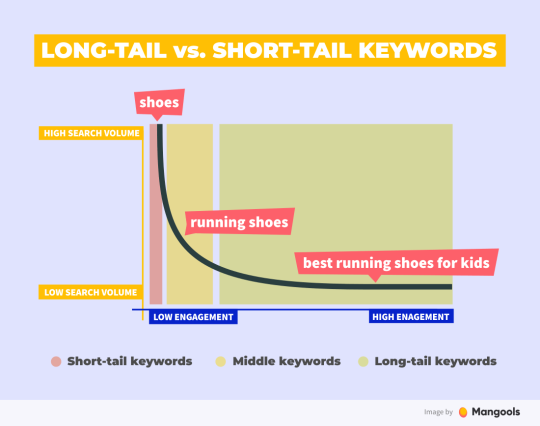
As you can see in the image, the visitors coming through long-tail keywords may represent a significant share of all organic traffic you get. Internet is a place to give information, answer the questions and solve the problems. Your content strategy should aim at answering all the questions one can have about your niche. Long-tail keywords are a great way to find them. Pro tip: Long-tail keywords represent specific sub-topics within your niche. It does not mean that your content should always follow the pattern 1 long-tail keyword = 1 blog post. There’s an almost infinite number of possible long-tail combinations for a topic. It would be impossible to create a post for each of them. Instead, you can create a long-form content that will cover the whole topic and rank for the long-tail keywords naturally. You’ll find out more about the right usage of keywords in Chapter 4. Let’s take a look at a few places that can help you find keywords people use naturally when discussing the related topics.
Google Keyword Planner
Google Keyword Planner had long been a go-to free keyword tool for many people. Over time, keyword research has become more complex. Nowadays, most SEOs replaced GKP with more advanced tools. To use the tool, you need to create a Google Ads account (it will take you a couple of seconds if you have a Google account already). After the signup, go to Tools – Keyword Planner.
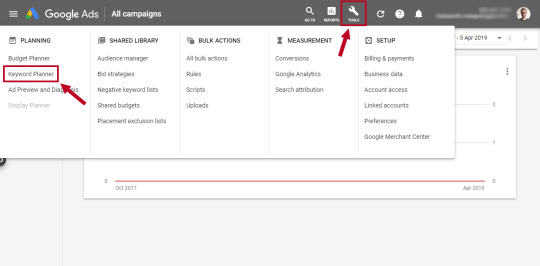
Select Find new keywords and enter the seed keyword(s) to get the suggestions.
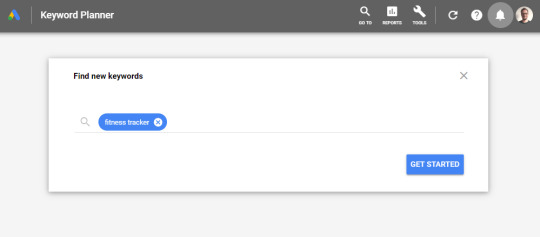
After that, you’ll see a list of keywords sorted by the relevance to the seed keyword.

Google Keyword Planner is a great tool that offers many valuable data for PPC campaigns (you can check our beginner-friendly guide in SEOpedia). For SEO, it provides hundreds of keyword ideas but does not fully replace a keyword tool. It can still be a useful tool, as long as you remember two things: The search volumes are very often grouped based on the close variant keywords. Also, you’ll only see search volume ranges (e.g. 1K – 10K) unless you spend enough money in Google Ads. Google Keyword Planner is part of Google Ads (formerly Google AdWords). Its competition column does not reflect the organic difficulty, only the competition in the PPC campaigns. FURTHER READING New Keyword Planner by Google: What’s in for SEO and PPC?
Keyword research tools
The most common way to find plenty of keyword opportunities is to use a keyword research tool. There are many tools on the market – KWFinder, KeywordTool, Long Tail Pro, to name a few… You may ask – should I pay for a keyword research tool? Of course, the answer depends on many things, but my recommendation is this: “If your website or blog brings you money in any way, keyword research tool (or an SEO toolset in general) is a great investment that will return value.” The main advantages of using a professional keyword research tool: It saves you a lot of time (you get hundreds of keywords ideas literally in one click) It offers data you wouldn’t find elsewhere (like keyword difficulty, search volume, SERP data) It gives you a competitive advantage (against those who don’t use any keyword tool) I mentioned that any keyword research usually consists of three main steps: FINDING, ANALYZING and USING the keywords. With a keyword research tool, you’ll cover both the first and the second step. There are two basic methods to approach the research in a keyword tool: Search based on a seed keyword Competitor-based research 1. Search based on a seed keyword As suggested in the name, this method starts with a seed keyword. This can be any phrase that describes the topic. If you want to create content about coffee machines, just enter the keyword coffee machines into the tool. Note: When talking about keyword research tools, I’m using KWFinder as an example tool in this guide. It supports both seed keyword and competitor keyword research. The suggestions are based on the topical relevance as well as autocomplete feature – keywords containing the seed keyword + other word(s). Besides the keyword suggestions, a quality tool offers SEO metrics that will help you analyze and pick the right keywords.
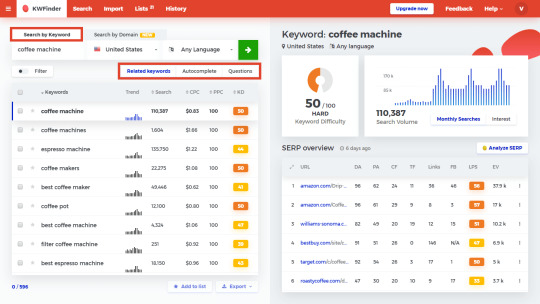
Search based on a seed keyword in KWFinder You can quickly check the exact search volume, the difficulty of the keyword and the search results page (SERP). We’ll talk about the meaning of these metrics and the ways to analyze the keyword in the next chapter. 2. Competitor-based keyword research Competitor keyword research is one of the most valuable features of keyword tools. Why? Because it is a super-tedious work to find your competitors’ keywords manually. You would literally have to go page by page and guess the keywords your competitors focus on. But it is a matter of few clicks with a proper tool. There are two basic ways to do it: a) Check your competitor’s domain to get new topic ideas By checking the keywords your competitor ranks for, you can find new interesting topic ideas you can cover with your website. In the example below, I have entered the domain of a popular blog about coffee homegrounds.co. The tool shows a list of hundreds of keywords this website is ranking for. As simple as that.

b) Check specific URL to get keyword ideas for a specific topic This technique is usually used if you already have a topic in mind. Let’s say you want to write an article about “pour over coffee” for your coffee blog. Just enter the keyword into Google and see who ranks for it. If it’s not you, it’s your competitor 🙂

Once you found the competitor, just enter the URL of his article and you can see other keywords the article ranks for. All of them are keywords closely connected to your main topic.
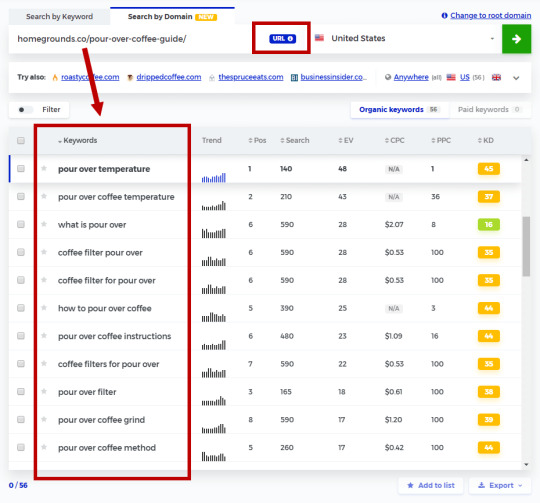
In the screenshot, you can see that one article about “pour over coffee” ranks for other related terms such as: “pour over coffee temperature” “pour over filter” “pour over coffee instructions” “what is pour over” All of them are keywords you can use in your own piece of content. Pretty cool, right?
Google suggestions
Google offers many keyword suggestions directly in the search to help people find the most relevant results. Let’s take a look at the 3 features you can leverage to find new keyword ideas: Autocomplete You probably noticed that Google tries to suggest related search queries directly in the search form. As these are based on real searches by people, they can be a nice inspiration for interesting keywords.
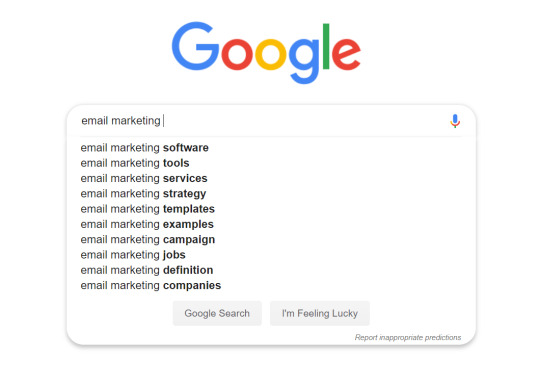
Start by typing your seed keyword into Google search and add letters (or numbers) to see the suggestions.

We can try various combinations: Email marketing a, b, c… Email marketing ab, ac, ad… Email marketing 0, 1, 2… Best email marketing… People also ask One of the features you can find in Google search results is the so-called “people also ask” snippet. It appears mostly for question queries and suggests other related questions.
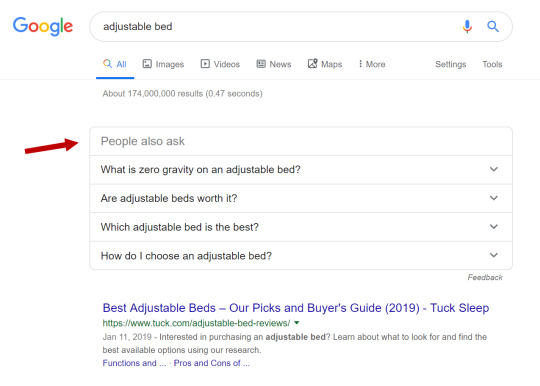
These can serve as an inspiration for long-tail question-type keywords. Pro tip: If you click on one of the questions, more related questions will appear. This way, you can load the “infinite” number of questions.
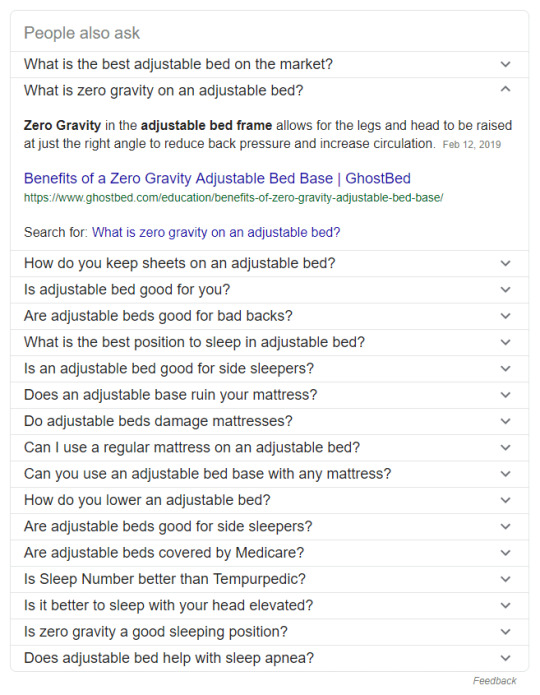
Searches related to… This feature is very similar to autocomplete, but the suggestions are at the bottom of the results page.
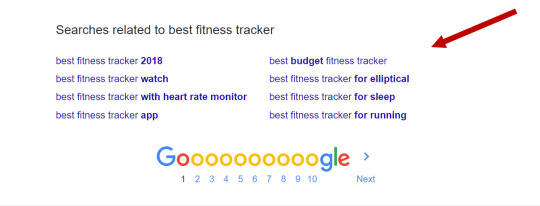
Pro tip: Besides Google, almost all the other search engines offer their own suggestions and related terms. You may not get many keywords you wouldn’t find in Google, but it is worth the shot. You can try Bing, Yahoo or DuckDuckGo.
AnswerThePublic
Even easier way to extract the autocomplete suggestions is to do it automatically. One of the tools that do it for free is AnswerThePublic. Just enter your seed keyword and it generates the autocomplete suggestions from Google and Bing for each letter in the alphabet.
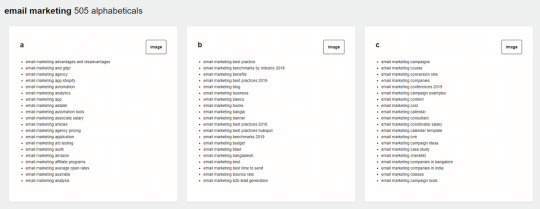
The feature I like the most is generating keyword suggestions based on: Question words (when, how, where, what, can, will…) Prepositions (for, without, to, with,…) Comparison words (like, versus, and, or,…)
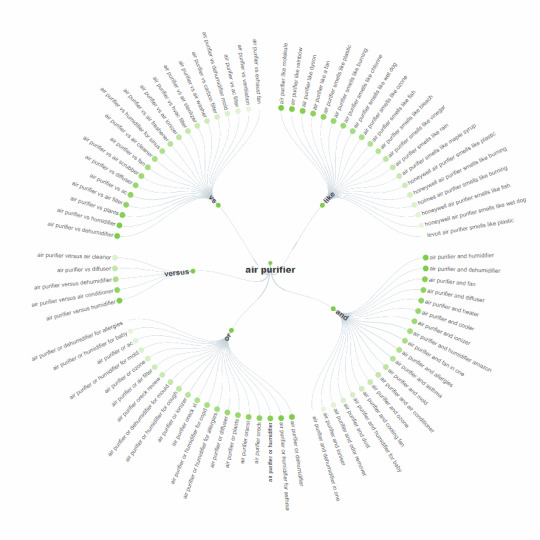
Keyword suggestions for “air purifier” based on comparison words (click to enlarge). Pro tip: If you are not a big fan of the default circle visualizations, you can download the keywords as a list too.

YouTube suggestions
YouTube is the second largest search engine in the world. Although keyword research for this platform has its own specifics, it can be useful for Google keyword research too. There are thousands of searches behind the most popular topics. There is a high chance that popular keywords from YouTube will have high search volumes in Google too. Let’s take an example. If we search for “water filter” on YouTube, we’ll find an obvious keyword idea in the title of one of the video results – “diy water filter”.
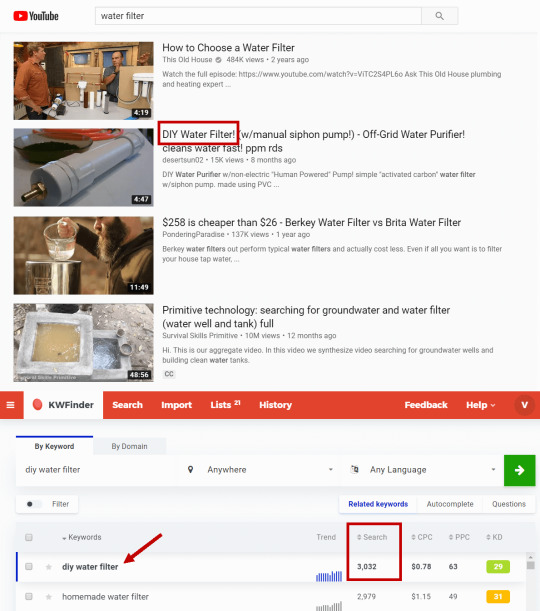
A quick check of the search volume tells us that the phrase is really popular in Google search too. Another way is to use YouTube Autocomplete feature. When looking for videos on YouTube, people usually use search queries that are more “practically” oriented. If you compare Google and YouTube autocomplete suggestions, you can see they are different.
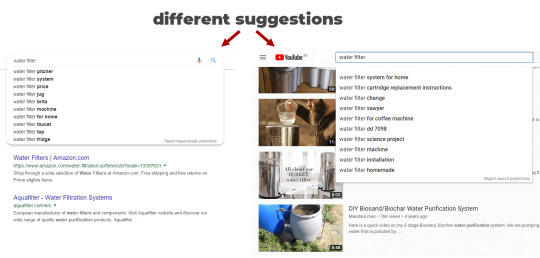
There are some useful tools such as YouTube Keyword Tool that scrapes the autocomplete results automatically. Pro tip: You can import the YouTube keywords to a keyword tool to see the search volumes and keyword difficulty values.
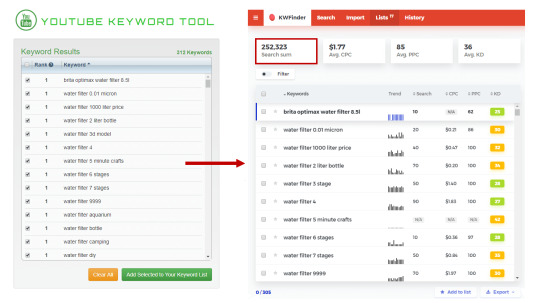
Google Search Console
A great way to find highly relevant keywords is to check what you already rank for in Google Search Console. If the article already ranks for some keywords, there is a high chance you’ll find other long-tail phrases it ranks for too. Let’s take a look at 2 ways to find keywords with the best potential: 1. Check keywords with high impressions but low number of clicks Keywords with a high number of impressions and very low number of clicks may indicate that there is a big traffic potential but you are not ranking high enough (or you were ranking for a short period of time and not anymore). Note: This applies to keywords you rank for on a 2nd or lower SERP. If you rank on the 1st SERP, but the clicks are very low, it is an issue with low click-through rate. Go to your Search Console and select Search results in the Performance section. You can check all the keywords you rank for with the domain (default Queries setting). Or you can go to Pages, select a specific URL and then click back to Queries to see keywords you rank for with that specific URL.

Next, sort the results by the number of impressions. You should look for keywords that could be relevant for your content but have low number of clicks. In the example below, you can see the results for our SEO guide for beginners. We can see the keywords: “seo basics” “how to seo” “how to do seo” “ultimate guide to seo” They are all relevant but the post clearly doesn’t rank well for them – they have a high number of impressions but a low number of clicks.

What can we do? Analyze the keywords to see whether they are worth the effort (especially in terms of search volume and difficulty – see the third chapter). If they do, we can improve the optimization of the article for these keywords. 2. Check what you rank for on the 2nd or 3rd SERP By checking the average position for the queries, you can find that you rank on the 2nd or 3rd SERP for keywords that were not the main focus of the article and yet, bring you impressions and clicks. All you need to do is to select the Average position in the Performance section (it is not displayed by default). Then sort the queries by this dimension.

Although it is by no means the most accurate way to see your rankings, it will help you find low-hanging fruit among the keywords you already rank for. Let’s say you wrote an article about different types of coffee machines. In Search Console, you find the keyword “4 cup coffee maker” with an average position around the 2nd or 3rd SERP. Since the keyword is relevant and has a solid search volume, it could be a great source of traffic for your blog.
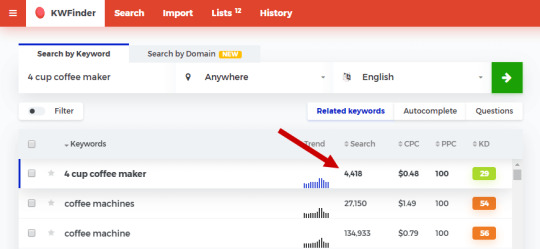
There are two things you can do: You can improve the current article to put more emphasis on the keyword. (However, you probably don’t want to cover such a specific subtopic in a general article.) You can write a new post focused on “best 4 cup coffee makers” and link it from the main article. With a quality article dedicated to the topic, you have a high chance of ranking for the keyword on a better position than with the general post. Tip: If you’re new to GSC, check out our simple Google Search Console guide and learn all the basics.
Reddit
Reddit is one of the biggest online communities that cover almost any topic you can imagine. As such, it can be a great place to find people interested in your niche and discover the topics they discuss. Let’s say your niche is aquascaping (I discovered this niche when writing this guide and I think I found my retirement hobby). Firstly, search for subreddits related to your niche. As you can see, even a specific niche such as aquascaping has thousands of followers in various subreddits.
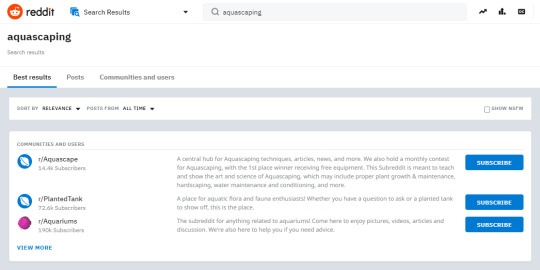
You can select a specific subreddit and look at the most popular posts. Alternatively, you can search for question-type posts within the subreddit. The search terms you can use: “question” “how can I” “how do you” “suggestions” “tips” You’ll find various questions related to the niche. They can be an inspiration for your next piece of content based on what people discuss online.

In the screenshot above, you can see possible topic ideas for the aquascaping niche. Pro tip: You can use a free tool called Keyworddit to extract the frequent keywords from a subreddit of your interest.
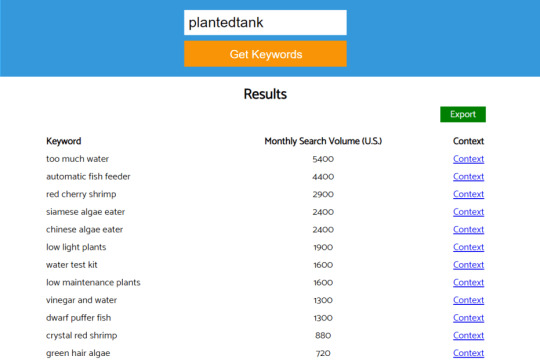
Quick and practical, right?
Quora
Quora is another popular platform focused on questions of any kind. As I mentioned before, every frequent question can be treated as a long-tail keyword. Here’s how to find the most popular questions for a specific niche: Let’s say your niche is email marketing. First, you need to find the topic page on Quora. Just type in your main keyword and select the appropriate result.
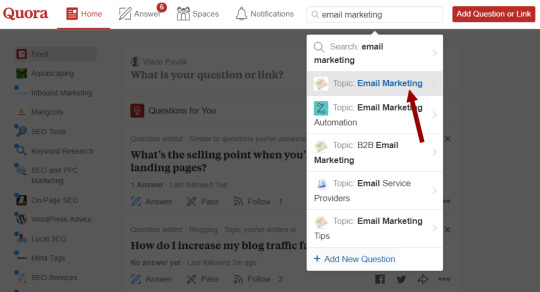
You’ll get to the topic page – over 750k followers, quite good. In the right panel, you’ll see a list of related topics, which might be useful to explore the niche further. Although it’s not possible to rank the questions by popularity on Quora, you can click on three dots and select “All Questions”.
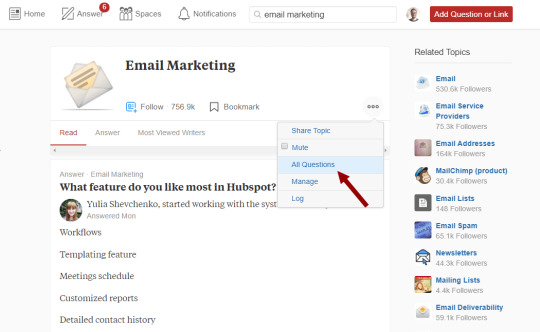
A list of all the questions within the topic will appear. Now you can browse through them and look for the ones with the highest number of followers/answers. In the example below, we see that the question “What are the best practices for sending cold emails?” has 246 followers. You just found quite popular topic within your niche.
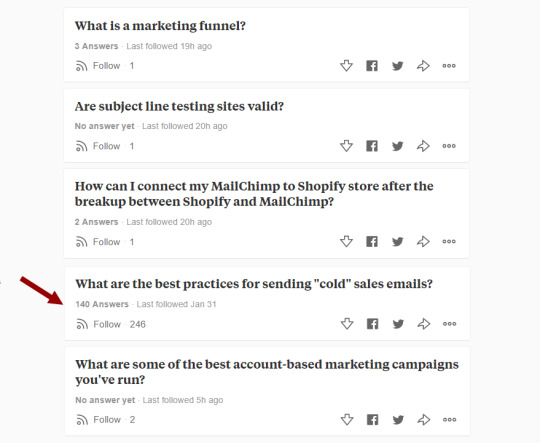
Of course, you don’t have to focus on the most followed questions only. “What is marketing funnel?” is a great example of a query that serves as a question and a keyword at the same time. There are hundreds of queries like this. Just dive into Quora and start discovering them.
Niche forums
Although forums are not as popular as they were in the past, various forms of narrow-oriented niche forums have survived. You can use these search queries to find forums related to your topic: “keyword forum” “keyword” + “forum” “keyword” + “forums”
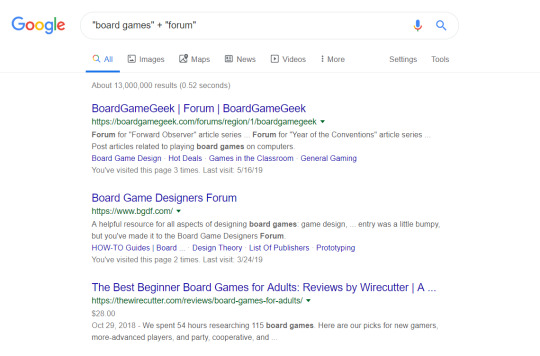
Here’s an example of an active forum in the board games niche:
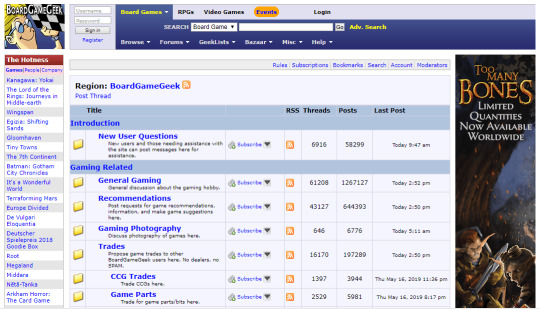
Tip: Look at the number of posts/comments and the last post dates to identify whether the forum is active or not. By diving into a specific category, you can find a lot of threads and possible keyword ideas based on the topics people actively discuss.
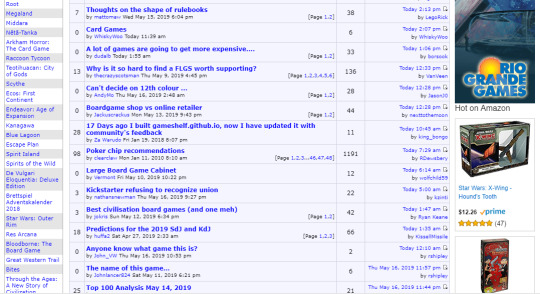
If you see a niche forum that looks like it came straight from the 90s, with thousands of threads and last post from an hour ago, you’ve found a gem.
Amazon
Did you know that Amazon has its own search engine called A9? Similarly to Google and YouTube, it collects data about popular search queries and offers automatic suggestions. You can search for them manually or use one of many free tools that do that automatically.
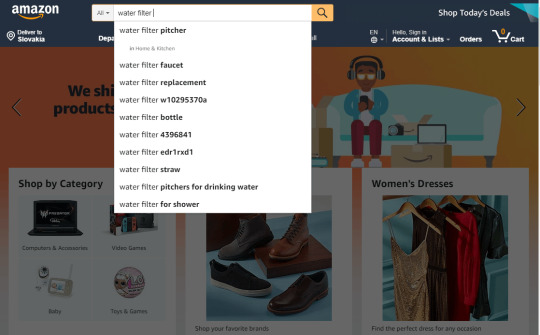
The relevance of the suggestions is based on the product conversion rate and buying behavior. These keywords may be especially useful for the content with transactional intent. Are you an affiliate marketer? An e-commerce store owner? Don’t forget about Amazon.
Wikipedia
Wikipedia is a great source of keywords too. Thanks to its nested structure, you can go from a broader topic to narrow sub-topics. Browsing through tables of contents and sub-chapters is a great way to do it. Here is an example of the search going from a broad keyword to a very specific topic: Exercise (main topic) – Fitness (subtopic) – Physical fitness (article) – Aerobic exercise (article) – Types of aerobic exercise (chapter) – Indoor rower (article) – Indoor rowing techniques (chapter) I got from a wide topic such as exercise to a specific sub-topic/keyword like indoor rowing techniques within minutes.
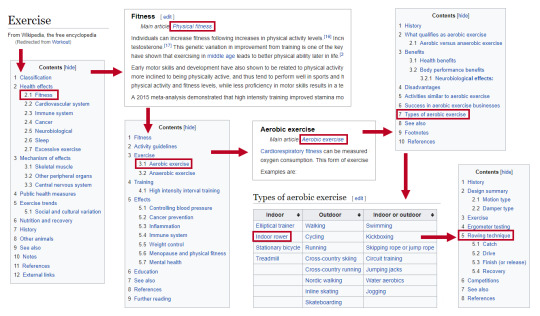
For some big topics, you can find a comprehensive table of related subtopics at the bottom of their Wikipedia page. This can give you a great insight into the structure and depth of the topic.
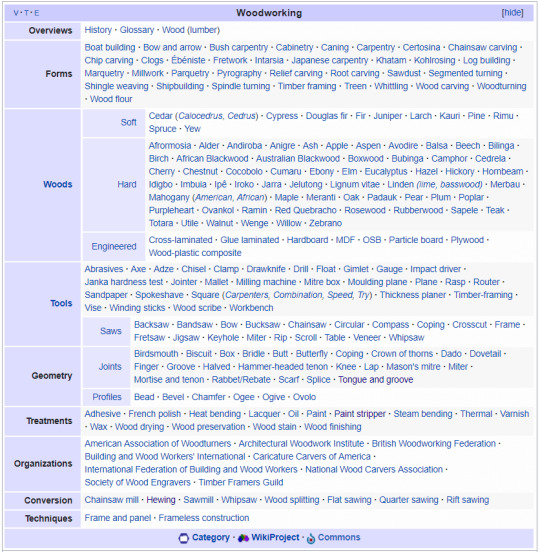
Last but not least, you can use a free tool (like this one by Karooya) that will scrape the topic ideas and keywords from Wikipedia for you:
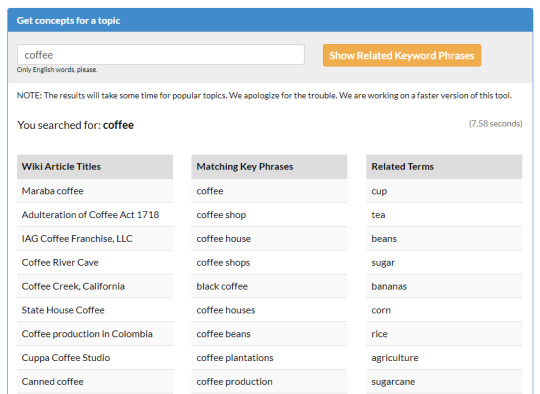
Quite a huge source of keyword ideas, right?
Feedly
Another way to get a lot of topic ideas is to set up an RSS feed to get updates on new content from the best blogs from your industry. The whole process won’t take you more than 5 minutes. Just register a free account at Feedly, create a new feed and follow the industry leaders and competitors. You can start by entering your topic and following the best blog within the niche:
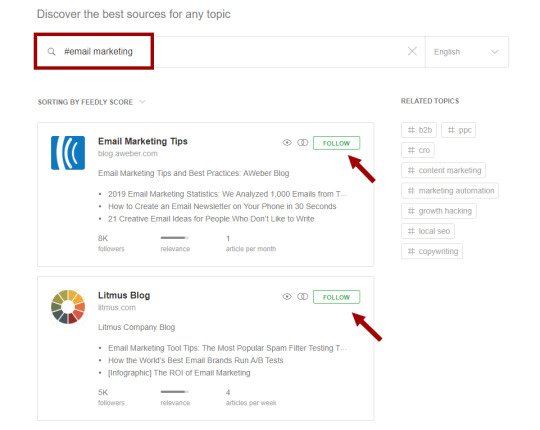
Every day, you’ll see a digest of the new content published on the blogs you’ve been following.

Each post title can serve as a separate source to find content ideas and keywords you can focus on with your own website. Of course, there are many other places that can be a source of keyword inspiration. Just look for places people from your niche gather online. It could be: Twitter threads Facebook groups Content curation platforms etc. Keyword ideas can be found everywhere. But not all keywords were created equal. How to analyze them to find the ones worth targeting? Let’s take a look at the third chapter.

Chapter 3
How to analyze keywords
Now that you have dozens of keyword ideas, your main task is to select the ones that will bring the most value to you. You don’t want to optimize for hundreds of keywords, right? There are three key aspects to consider – popularity, difficulty and relevance of the keyword. I like to think of these 3 aspects as 3 legs of a tripod so I called it The Tripod Rule of Keyword Research (I should register a trademark :D)

Why tripod? Because it stands steady only if all three legs have a good ground. The same applies to any keyword: If a keyword has a high search volume and low difficulty but isn’t relevant to your content, Google won’t show your page for the keyword. If the difficulty is low and the keyword is relevant but there is no search volume, you’ll get no traffic. If search volume and relevance are OK, but the difficulty is too high, it will be hard to outrank your competitors. …we all know what happens to a tripod if you take one of the legs.

Let’s take a closer look at these 3 legs:
1. Popularity of the keyword
The popularity of the keyword usually means the search volume – how many people search for the given phrase. It is usually calculated as a monthly average based on the last 12 months. There are two basic sources of search volume data used in keyword research tools: Google data – search volume data from the Google Keyword Planner database Clickstream data – search volume data based on the behavior of internet users (collected from browser extensions, plugins, etc.) Various keyword tools use different sources and different ways of data post-processing. As a result, there may be differences in search volume values. Both sources have their pros and cons and none of them is 100% exact. Note: Don’t forget that a well-written content will most probably rank for many other keywords and the total search volume will be higher. Don’t become a slave of search volumes, take them as a clue.
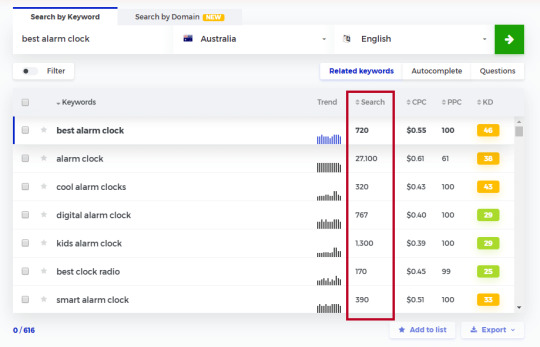
You should also look at the popularity of a keyword from a longer perspective by checking a long-term interest trend of the keyword. A great tool to help you with this is Google Trends. You simply enter a specific keyword or topic and the tool will show you the interest over time on a scale from 1 to 100. Look at these four very different trend chart examples:

The keyword 3D television may have a solid monthly search volume (actually, it is around 2,400 searches per month globally). But if you look at the long-term trend, you’ll see that the interest is dropping in the last couple of years. Google Trends can also help you spot the seasonality of the keyword. Seasonal keywords are keywords bound to specific time of the year (summer/winter, holidays, annual events). Look at the keyword garden pool in the screenshot above. There are natural spikes during the summer period and lower interest in the winter. You should consider this when creating the content plan.
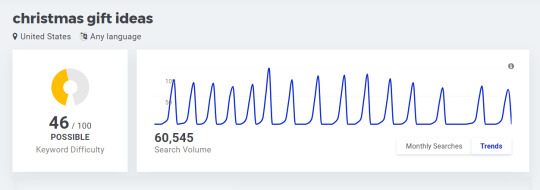
Another example of a seasonal keyword trend graph from KWFinder. Last but not least, you should take into account the click-through rate (CTR). The CTR depends widely on the position of your website. There are other things that influence it, especially the rich snippets. These include: Google Ads Featured snippets Answer boxes Map packs Many other snippets Here is a graph representing the organic CTR in the result pages with and without Google ads. As you can see, if the ads are present, the CTR of organic results is much lower.
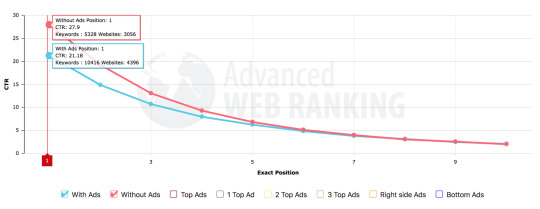
There are tools that calculate the impact of rich snippets on the organic results. You can take it into consideration when estimating the visits you can get from a keyword.
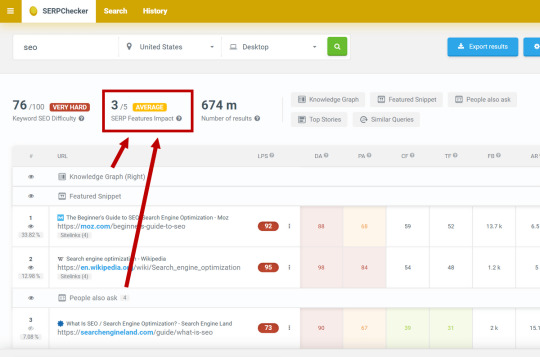
The impact of SERP features on the engagement calculated in SERPChecker. Let’s take a look at the second leg of our tripod. Quite an important one.
2. Keyword difficulty
Keyword difficulty is a metric that estimates how hard it is to rank for a certain keyword. The higher is the keyword difficulty, the harder it will be to rank for the keyword with your website. The difficulty metrics used in keyword tools take into consideration the authority of the websites ranking in the 1st SERP.
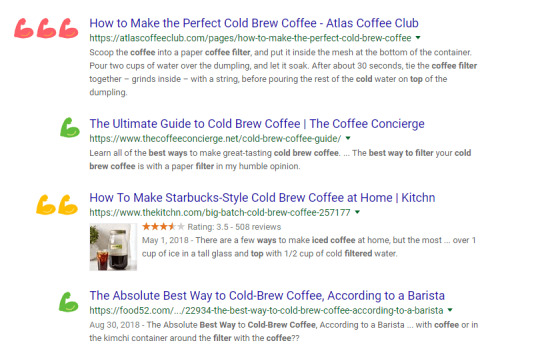
Each website in the SERP has a certain authority that can be calculated in various ways. If there are many low-authority websites in the first SERP, there is a high chance of ranking for the keyword. How is the website’s authority calculated? In most cases, the calculation takes into account on two things: Number of backlinks – how many pages link to the given website Quality of backlinks – depends on the authority and relevance of the linking pages There are various well-established authority metrics. The most popular are Domain Authority and Page Authority by Moz and Citation Flow and Trust Flow by Majestic. These metrics try to capture the authority of the page into one number on a scale from 1 to 100. If you consider the authority of all the websites ranking for a keyword in the 1st SERP, you can estimate how difficult it will be to rank for that keyword.
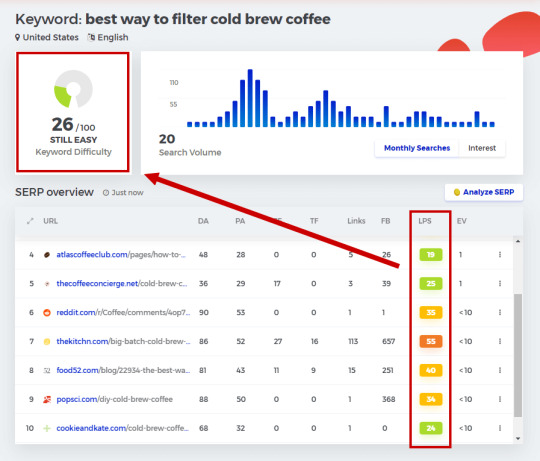
Keyword difficulty metric based on the authority of the websites in the first SERP. To work with the keyword difficulty metric correctly, it is important to remember a couple of things: Don’t take the keyword difficulty as the only clue. The metric should serve only as a guideline, not an absolute value. If your content is better and more relevant, you can outrank websites with higher authority. Don’t compare the numbers between different tools. Each keyword research tool uses different data to calculate their keyword difficulty so the values will differ. Instead, compare the difficulty metrics between the keywords. Don’t forget about the subjective factors. No metric can tell you exactly how hard it will be FOR YOU to rank for a certain keyword. There are many subjective factors you need to consider, namely: your SEO skills, your website’s authority, the relevance of your content. Pro tip: Find competitors with similar website authority as yours (you can compare DA/PA or CF/TF for example). Then, look at the keywords they rank for and create better content to outrank them. Alternative ways to estimate the keyword difficulty Although difficulty metric is probably the most reliable way to estimate the competition, there are some other ways: Domain age – you can focus on the age of the domains to find SERPs with relatively young ranking websites. For example, a keyword with a 6-months-old website in the first SERP could be easy to rank for. Keyword Golden Ratio – this method allows you to find long-tail keywords you should be able to rank for immediately. Read more about it in our Keyword Golden Ratio guide. Pro tip: Sometimes, if there is no relevant content, Google simply displays semi-relevant websites with high authority. If you check the difficulty metric, you would see a high number. (Remember? The difficulty is calculated based on the authority of the websites in the SERP) It does not mean that you can’t outrank them with a highly-focused, relevant content. You should always do the SERP analysis and not rely on the difficulty metric only. Speaking of relevance, here’s the third leg of the keyword research tripod:
3. Relevance (search intent)
SERP analysis should be an integral part of every keyword research. Firstly, you can better evaluate the keyword difficulty by looking at the authority of the ranking websites. Secondly, it helps you to discover the search intent behind the keyword to see whether the keyword is relevant to your content. There are 4 basic search intent categories: Navigational – user is searching for a specific website/brand Informational – user is searching for general information Transactional – user wants to buy something online Commercial – user wants to do the research before purchase Here are some example keywords and content types for each search intent:
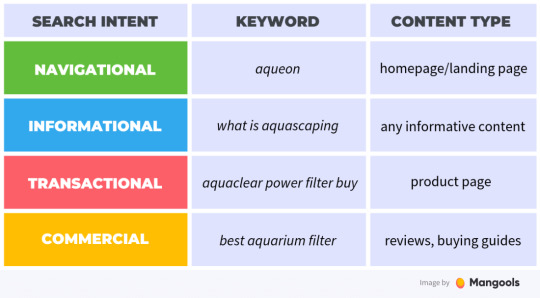
The best way to discover the intent behind the keyword is to Google it and see what ranks in the first SERP. Sometimes, the keyword may be topically relevant to your page, but not relevant in terms of the search intent. Let me give you an example: Let’s say you own an online aquarium supplies store and you want to find a focus keyword for the product page of a new advanced aquarium filter AquaClear. You find a keyword “best aquarium filter”. It has a solid search volume and it seems quite easy to rank for. FURTHER READING Identify search intent from SERP data AquaClear – the best aquarium filter for your fish tank! Quite a catchy title, right? However, a quick look at the SERP will show you that your chosen keyword is not suitable for your content. Why? The search intent doesn’t match.

Google clearly understands “best aquarium filter” as a commercial keyword – all the results are reviews and buying guides. You wouldn’t be able to rank with your product page, because it has a transactional character. You have two options now: Find a focus keyword with a suitable intent (e.g. “aquarium filter buy”, “aquaclear filter price”) Create a new piece of content to match the search intent (e.g. a comparison of the best aquarium filters with links to your online store) The main goal here is to match the intent behind the query with your content type. Pro tip: Do not focus only on transactional and commercial keywords. Write informative blog posts and offer some value for free. Some of your visitors may not want to buy immediately, but they’ll remember you as an authority in the field when they are ready to buy in the future. We’ve covered the first two steps – finding and analyzing the keywords. It’s time to move to the third step.

Chapter 4
How to use keywords
Now that you analyzed the keywords, you can start thinking about how to use them within your content. Many keyword research guides end at this point. You’ve found the keyword. You picked the ones with the best metrics. The question is: What to do next? In this chapter, we’ll take a look at some useful principles and tips on how to use the keywords properly. They’re closely connected to on-page optimization and content strategy, but very relevant to keyword research too.
Think of keywords as topics (topic cluster model)
Topic clusters represent the basic structure of your website content. Instead of organizing the articles into artificial categories or, even worse, having no structure at all, organize them by topics. Here is a scheme of a typical topic cluster model:
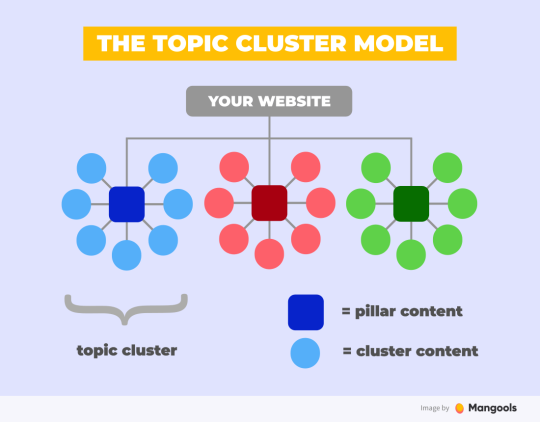
There are two main types of content in the cluster model: Pillar content – the main post or page broadly covering the topic – targeting broader keywords Cluster content – supporting blog posts explaining the subtopics in detail – targeting more specific keywords The pillar content and supporting cluster articles are interlinked in a way depicted in the scheme above. The topic cluster model method strengthens the semantic relationship between the articles. As a result, it can help search engines to better evaluate the topical relevance of the posts. You can use the model to organize your keywords into keyword lists where 1 list = 1 topic cluster.
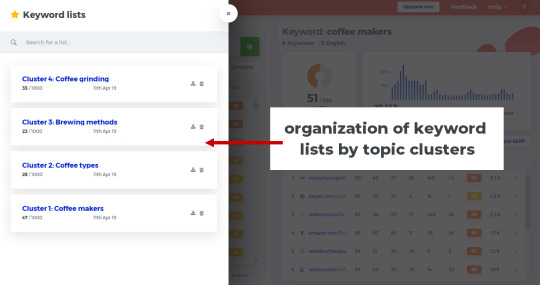
That’s the theory, let’s take a look at a specific example: If one of the topic clusters on your coffee blog focuses on the coffee types, the keywords and content titles may look like this: Focus keyword and pillar article title: coffee types (The Ultimate Guide to Different Types of Coffee) Focus keywords and titles of possible cluster articles: flat white latte (A newbie’s guide to flat white) how to make espresso (How to make a perfect espresso) difference between latte and mocha (What is the difference between latte and mocha?) best coffee beans for espresso (Best espresso beans on the market (expert review)) If you take keywords as separate content topics, it makes you think about the natural relationships between them. You’ll understand that keyword research is not only about search volumes and difficulties. First of all, it should help you understand the way people search and think on the internet. This helps you to create content that covers the topic thoroughly and satisfies users’ needs.
Select the focus keyword
Select one focus keyword that represents the topic. Don’t overuse the keyword. The best practice is to use the exact-match keyword in: The title (both H1 and title tag) Meta description One of the first paragraphs of the text At least one subheading A couple of times in the text (naturally) That’s it. Everyone knows that keyword stuffing is an outdated technique. Do not try to stuff the exact match keyword into the post to meet certain keyword density (there is no ideal number and never was). Tip: Some SEO plugins (such as Yoast SEO) suggest the optimal keyword density. Take it as a clue, but never forget about the user experience. If your focus keyword is “social media scheduling for agencies”, it would look unnatural to use it 5 times in a 1000-word article. Always consider the length of the keyword too. Instead of keyword stuffing, you can focus on the so-called LSI keywords.
Use various LSI keywords
Latent semantic indexing is a term that refers to a specific mathematical method. It is used by search engines to identify which keywords are semantically related. LSI keywords are keywords that are closely related to your main keyword. They often appear together with your main keyword.

An example of the LSI keywords used within the topic cluster model scheme The main goal is not to rank for all of the LSI keywords you use, but to let Google know the extent to which you cover a certain topic. That will help to improve the topical relevance of the article. According to this study by Ahrefs, the average #1 ranking page will also rank for about 1000 other relevant keywords:

Pro tip: After a certain time, use the Search Console technique to find long-tail keywords you started to rank for. Think about ways to tweak your content to improve the positions. Again, be careful when adding the LSI keywords and use them only if it fits into the text naturally. Trying to optimize for every variation or synonym of a keyword can be harmful the same way as keyword stuffing. There’s an old SEO joke that goes like this:

Although exaggerated to make the point, it shows that artificial usage of LSI keywords is not the right path to follow. It can be easily identified and it hurts the readability. Google algorithm is becoming better at understanding the content and knowing what the page is about. You don’t need to use every single keyword.
Write long-form content
Various researches have proven that on average, a long-form content (over 1500 words) ranks better than short articles. The advantages of long-form content: In a long text, LSI keywords are used naturally, which increases the topical relevance Long-form content usually has higher engagement as it answers the user’s question (or solves the problem) in a comprehensive way It naturally attracts more links than short, mediocre articles It improves the image of your brand as an authority in the field The question is: How to use the keywords in a long-form content? As I mentioned in the previous point, you don’t have to use every single related keyword. You may actually rank for keywords you didn’t even use in the text. Let’s take a look at this example: If you look for a keyword “how to make strong coffee”, the first result is an ultimate guide by a coffee blog Enjoy Java.
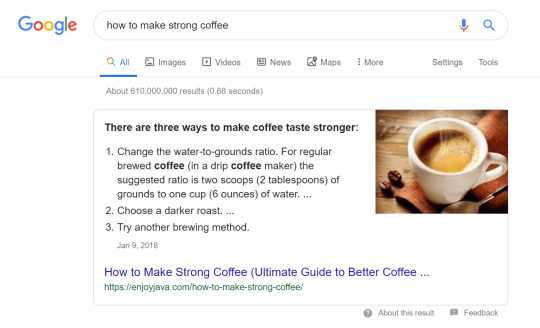
A quick look at the article will reveal that it is a well-written, comprehensive post with a ton of useful information, tips and videos. With the word count of 2780 words, it is a typical long-form article covering the topic from A to Z.
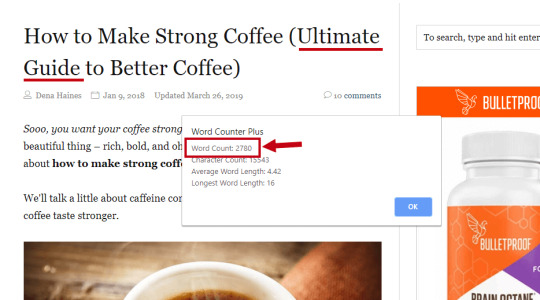
If we run the post through a keyword research tool, we’ll see that besides the original keyword we searched for (“how to make strong coffee”), it ranks in the first SERP for another 18 keywords in the US.

Now, let’s look for the appearance of these keywords in the article. I searched for the exact match of all these keywords in the article. All in all, 14 out of 19 keywords the article ranks for in the first SERP are not even mentioned in the exact form in the whole text!
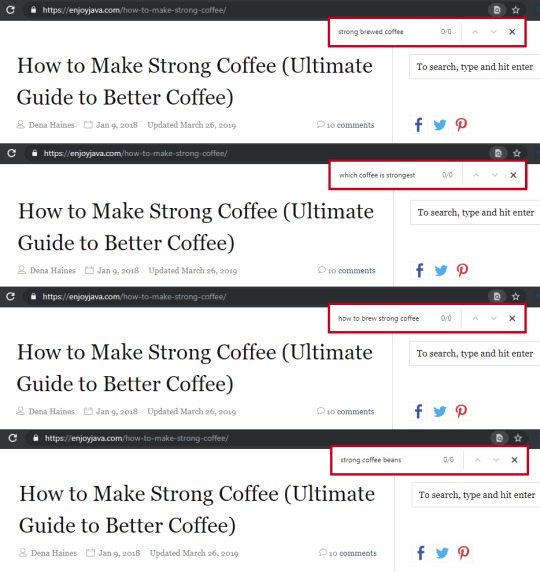
I checked the source code – the keywords are not present in the meta or alt tags either. The author of the guide could write 3 separate articles with these focus keywords: strong brewed coffee which coffee is strongest strong coffee beans Instead, he wrote an ultimate guide that covers the whole topic of “strong coffee” and he ranks for all these keywords (and many more) naturally. What does it mean? If Google sees that your content is top-notch and relevant, you may rank for keywords you did not optimize for at all. tldr; How to use keywords in your content strategy Do’s: think of the main keywords as topics select one focus keyword that will represent the topic and follow the best practices of keyword placement write long, in-depth articles that cover the whole topic thoroughly use LSI keywords to increase topical relevance Don’ts: don’t follow the pattern 1 long-tail keyword = 1 article don’t overthink the number and placement of the keywords don’t follow the keyword density recommendations don’t stuff the keywords into the text unnaturally Read the full article
#keywordexplorer#keywordfinder#keywordgenerator#keywordplannergoogle#keywordresearch#keywordresearchtool#keywordsearch#keywordsearchtool#keywordtool#keywordtooldominator
0 notes
Text
illustration #4



Purgatorio / Dante Alighieri


A Mid Summer Nights Dream / William Shakespeare

The Divine Comedy / Dante Alighieri


The Human Stain / Philip Roth

Vanity Fair / William Makepeace Thackeray


Read the full article
#illustrationart#illustrationboard#illustrationdefinition#illustrationessay#illustrationexchange#illustrationlibrary#illustrationmeaning
0 notes
Text
illustration #3

































































Read the full article
#illustrationart#illustrationboard#illustrationdefinition#illustrationessay#illustrationexchange#illustrationlibrary#illustrationmeaning
0 notes
Text
Google co-founders step down, Sundar Pichai to lead both Google and Alphabet
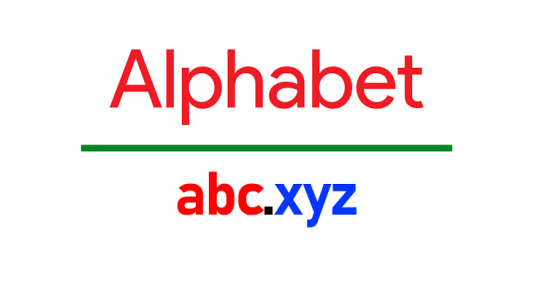
Page and Brin will remain as board members.
Earlier this afternoon Google announced that Google co-founders Larry Page and Sergey Brin would leave their respective roles as CEO and President of Alphabet. Current Google CEO Sundar Pichai will now become CEO of Alphabet as well. Brin and Page will “remain active” as shareholders and board members of the company.
Why we should care
Sundar Pichai became CEO of Google roughly four years ago, just after holding company Alphabet was announced. He had been the company’s product chief. Since that time revenues have grown from roughly $74.5 billion to $136 billion last year. The company’s share price has more than doubled and its market cap has grown from just under $500 billion to roughly $900 billion today. Investors will be unfazed by this transition and may regard it as entirely positive. Page and Brin have not been involved in the daily operations of the company for a long time. Pichai will now be the sole leader atop of Google’s digital empire, presiding over the company at a time of both opportunity and peril. Regulators across the globe are seeking ways to rein in the company and impose new controls on how it operates. In addition, there’s internal tension as activist employees voice concerns over a range of both internal and external issues.
More on the news
In a letter from the two founders, they said that the company didn’t need two CEOs and a president. They said that Alphabet was “well-established” and Google’s “Other Bets” were operating effectively as independent companies. The move is seen as simplifying the company’s management structure. Read the full article
#alphabetchart#alphabetfitbitoffer#alphabetincursive#alphabetinc#alphabetletters#alphabetsong#alphabetstock#alphabettrain#alphabeticalorder#alphabetizer#GOOGLE#Google:BusinessIssues
0 notes
Text
Google My Business phone support has ended, but help from the experts has not

Google's social media channels are reported to be helpful as well as connecting with local search pros.
Google has officially shut down its phone support for Google My Business, but that doesn’t mean you can’t get quality support. I wrote an article back in 2015 about phone support, and I still get questions about that post all the time, so I figured it was time for a follow-up about the current support options.
Phone support is gone (but not really)
On Nov. 11, Google officially shuttered Google My Business phone support and removed the numbers from the GMB home page. If you happen to have one of the numbers saved, you’ll hear a short voicemail directing you to the Google My Business Help Center. If you click “contact” at the top right, you’ll see a list of potential issues – for many of these, you can still select a call back from Google support – but that’s not always the easiest solution. Sometimes you’ll get lucky and get a great support rep that helps solve your problem quickly. Other times you’ll get someone who’s entirely script-based and it’ll take some patience to get to the root of your problem and find a solution.
Local Search Forum is a helpful resource
Most of the time, the local search community is your best resource for assistance with Google My Business help. Joy Hawkins (a fellow Search Engine Land columnist) runs the Local Search Forum, which is probably the best place on the internet to find info on local search issues and tactics. Just head over to the forum’s “Google My Business & Google Maps” discussion and drop in your question. You’ll usually get an answer pretty quickly from one of the Local Search pros who frequent the forum.
Google My Business Forum is responsive as well
The Google My Business Forum is an awesome resource if you’re having any problems with your GMB listing. You can’t talk to anyone from Google, but it’s managed by Google “Product Experts” (basically, GMB superusers who have special access to Google because they’ve helped users on the forum for a long period of time). In most cases, the product experts will be able to answer your questions or help you with your problems, but if they get stumped, they can escalate issues directly to Google. The forum is a great place to get help with reinstating suspended listings, report inappropriate reviews or Q&A content, report GMB or maps spam or to get help with verification of a listing. Read the full article
#googlemybusinessaccount#googlemybusinessapi#googlemybusinessdashboard#googlemybusinesshours#googlemybusinesslisting#googlemybusinesslogosize#googlemybusinessoptimization#googlemybusinesspage#googlemybusinessprofile#googlemybusinessservicearea
0 notes
Text
Privacy-focused, rewarded ads browser Brave tops 10M monthly active users

MAUs have doubled in the past year.
Brave said it has seen a surge in user adoption since releasing version 1.0 of the privacy-centric browser on November 13, 2019. Monthly active users (MAU) have doubled in a year to 10.4 million as of the end of last month. DAUs. Daily active users of the browser created by Mozilla founder Brendan Eich have tripled in the last year to 3.3 million, the company said Friday.

Source: Brave Ad platform that rewards users. Brave Ads are structured to serve only to users that opt-in to the Brave Rewards program and agree to see ads. Users can then accumulate Brave’s Basic Attention Token (BAT), which is a blockchain-based system. Users get 70 percent of the ad revenue share “as a reward for their attention,” and publishers are allocated tokens in proportion to the amount of time users spent on their sites. Ads are targeted based on search and browsing data and machine learning models to build up profiles of users’ interests — that data lives solely on users’ devices. Brave Verified content creators. There are now nearly 340,000 creators across YouTube, Twitter, Twitch, Vimeo and other platforms that have signed on to Brave’s token payments program from Brave users. There were just 28,000 verified creators at the start of 2019. Why we should care. To be certain, Brave’s market share doesn’t even register among the competition of Chrome, Safari, Edge, etc., but its growth trajectory indicates there is a market for services that cater to privacy concerns as consumer awareness and regulatory measures and scrutiny increase. The privacy-focused search engine DuckDuckGo has also reported a surge in query activity this year. Text ads on the platform are syndicated by Microsoft Advertising. Read the full article
#bravebrowserapk#bravebrowserforwindows10#bravebrowserreview#browserbrave#browserbraveandroid#browserbraveclearhistory#browserbravefree#browserbravelinux#browserbravevsepic#browserbravevskiwi
0 notes
Text
Social shorts: TikTok under fire for discrimination, Facebook enforces special ads restrictions, Twitter expands Brand Surveys

The social media marketing week in review: A round up of news and announcements you may have missed.

This collection of social media marketing and new hire announcements is a compilation of the past week’s briefs from our daily Marketing Land newsletter. Click here to subscribe and get more news like this delivered to your inbox every morning.
Facebook’s anti-ad-fraud efforts, Twitter expands surveys
Facebook takes action against ad fraud. The social media giant filed a lawsuit Wednesday against one entity and two individuals for allegedly operating a hacking campaign targeting accounts on the social network. The alleged hackers are being accused of taking over their victims’ accounts to use their money to buy ads and fraudulent products, according to the lawsuit. Facebook said it’s paid more than $4 million in reimbursements to victims of these hacks. The company said it will continue to work toward mitigating malicious behavior on the platform, adding, “Creating real-world consequences for those who deceive users and engage in cloaking schemes is important in maintaining the integrity of our platform.” Twitter expands access to Brand Surveys. In a play to give marketers more ways to measure campaign lift, Twitter announced this week the general availability of Brand Surveys for all managed accounts in the U.S., UK, Canada, Japan and Brazil. According to Twitter, the tool can be used to help inform and improve campaigns with the added benefit of being a first-party solution, which Twitter says allows the platform to offer “a low minimum media spend requirement while still delivering statistically significant results.”
Facebook now enforces restrictions for special ad categories on all platforms
This week, Facebook announced it will be officially enforcing audience targeting restrictions for ‘Special Ad Categories’ across all of its ad management tools, including Ads Manager, Instagram Promote, the Facebook Marketing API, and ads created within Facebook Pages. The special ad category requirement is used for ads related to housing, employment, or credit opportunities, prohibiting these advertisers from targeting ads based on age, gender, ZIP code or multicultural affinity. The effort is a move on Facebook’s part to curb discrimination by advertisers. The ‘Special Ads Category’ was first introduced earlier this year for U.S. advertisers running housing, employment, and credit ad campaigns via Facebook’s Ads Manager. Starting this week, Facebook is expanding the requirements to all of its ad buying platforms, including Ads Manager app, Instagram Promote and the Facebook Marketing API. Facebook said it’s also making these ads available to view and search in the platform’s Ad Archive – an effort to deliver further transparency. Users will be able to view all active housing opportunity ads in the U.S. that started running on or after December 4, 2019, regardless of whether the user is part of the target audience. Users will also be able to search the Ad Archive by the name of the Page running an ad, or by the city or state where the ad is targeted. Facebook’s efforts to remove ad targeting options for housing, employment and credit advertisers are the result of a settlement the company reached with civil rights groups earlier this year, which charged Facebook with allowing discriminatory ads on its platform. Facebook first began rolling out the restrictions in March.
TikTok admits to taking the “wrong approach” to combat cyberbullying
TikTok faces discrimination backlash. The popular video-sharing app has admitted to censoring posts from users it identified as disabled, fat or LGBTQ+ as part of a misguided effort to mitigate cyberbullying. The revelation was made public by Netzpolitik.org, which spoke to a source inside the company and obtained private documents from the platform. The findings revealed that TikTok applied automatic restrictions to users who were “susceptible to bullying or harassment based on their physical or mental condition,” including, “facial disfigurement, autism, Down syndrome, or disabled people or people with some facial problems.” In a follow-up statement, TikTok said, “Early on, in response to an increase in bullying on the app, we implemented a blunt and temporary policy. While the intention was good, the approach was wrong and we have long since changed the earlier policy in favor of more nuanced anti-bullying policies and in-app protections.” According to Netzpolitik.org, the rules were implemented as recently as September of this year. Twitter rolls out a privacy hub. Twitter launched the Twitter Privacy Center – a centralized resource that advertisers and users can use to quickly and easily access the platform’s rules and policies – as well as personal data settings and privacy tools. The new site will contain information about Twitter’s initiatives, announcements, and privacy products, in addition to status updates on security-related incidents. “It should be easier to find and learn more about the work we’re doing to keep your data secure, including what data we collect, how we use it, and the controls you have,” the company wrote in a blog post.
Chrome extension shows Instagram Likes, Facebook tests “Favorites,” Snapchat couples up with Verizon
Return of the Like? Instagram is still testing hiding Likes – but a new Chrome extension from SocialInsider wants to give users the ability to view them again. Once added to your Chrome browser, the extension displays the number of likes and comments for any post on Instagram. The installation terms state that user data is not shared with Socialinsider servers. Facebook tests a feature similar to ‘Close Friends.’ Rumor has it the social network is experimenting with a new option that allows users to share their Facebook and Messenger Stories with a “Favorite” group of friends – rather than sharing with everyone. The feature bears a striking resemblance to Instagram’s ‘Close Friends’ feature, which adds a layer of privacy and speed for users who choose to share content with only a select group. Snapchat to be preloaded on some Verizon phones. Last week, Verizon and Snap announced a partnership that involves Verizon preloading the Snapchat app onto some of its 5G phones as part of a campaign promoting the 5G network. Snap will give Verizon ad placement in its Snap Originals programming, and it will also work with Verizon’s 5G Labs to build augmented reality experiences for live events and Verizon marketing activations. As Snapchat makes efforts to ramp up its AR capabilities (with plans to eventually roll out a wearable component), Verizon’s 5G speeds coupled with Snapchat’s audience reach could make the brand’s AR aspirations a reality. Get ready, advertisers. Read the full article
0 notes
Text
Reddit reports 30% increase in monthly active users, eclipsing Twitter and Pinterest

Reddit's total MAU hits 430 million.
Last year, Reddit reported 330 million monthly active users (MAU) on its platform. This year, Reddit’s 2019 trend roundup reveals that number has grown by 30% – adding an additional 100 million monthly users since 2018.
Why we should care
This significant growth means Reddit now claims more monthly users than Twitter (321 million) and Pinterest (320 million). After undergoing a massive site redesign last year, Reddit has reported an increase in page views and time spent on its website and app, along with user engagement growth. With the redesign complete, Reddit is focused on building out more comprehensive ad offerings – something it has been steadily accomplishing over the past year. This, coupled with a significant spike in users this year, is prime pickings for advertisers looking to target niche audiences through a platform that continues to grow in engagement.
More on the news
While user growth stands out as the most impressive takeaway, Reddit also offered a snapshot of the platform’s yearly growth in other areas: Reddit reports 1.7 billion thread comments were created this year – an increase of 37% from last year. Monthly view counts have also grown, resulting in a 53% increase from 2018. Redditors have created a total of 199 million posts this year, according to the company. Read the full article
#reddit50/50#redditcfb#redditmlbstreams#redditnba#redditnbastreams#redditnews#redditnflstreams#redditnhlstreams#redditpolitics#redditthedonald
0 notes
Text
Changes to Nofollow, Rel=”Bull”

Changes to Nofollow, Rel=”Bull”
Google today (September 10th, 2019) announced some changes to their handling of nofollow. You can read all about it here. In a nutshell, we used to have the nofollow directive. Google are now moving towards a hint format. That’s important, because a directive is considered a firm command, whereas a hint, is not. We used to have one directive: rel=”nofollow”. Now we have multiple hints: rel=”nofollow” rel=”sponsored” rel=”ugc”
WHY WOULD GOOGLE DO THIS?
By switching from a directive to a hint, it allows google to loosen up its interpretation of nofollows. My only suggestion here, is that they’ve found that indexation and ranking quality is becoming tougher, with blanket nofollow policies in place at many large PageRank black holes (large sites that nofollow all external links). Additionally, it helps them better understand linking relationships with paid incentives, by clearly marking them as such and not simply allowing them to fall into the nofollow black hole. This further enriches their dataset, while hopefully allowing them to improve the overall ranking model.
BUT WHY SHOULD WE DO THIS?
As SEOs, we have to interpret current recommendations and best practices, either in-house or for clients, and implement them according to both our existing resource restrictions and perceived benefit. That’s our job, as SEOs. Tagging up specific sets of links at a large publisher, in this format, wouldn’t be a tough thing to implement, but – right now I have absolutely zero understanding as to how this could possibly help us, as SEOs or publishers, with our ranking. Google are normally excellent at the carrot/stick approach – they forced PageSpeed on us, they forced HTTPs on us, both using ranking improvement or filters respectively. They know how to carrot/stick. I don’t see what either the carrot, or the stick are here. Until such a point, I personally can’t recommend investing development effort into implementing this new ‘hint’ format. Over to you Google 🙂 Read the full article
0 notes
Text
Google Chrome Dev Summit 2019 Recap: What SEOs Need to Know

How to Make Your Content Shine on Google Search – Martin Splitt
Talk Summary In this session, Google developer advocate Martin Splitt explored the latest updates to Google search that are being used to provide better user experiences and increase website discoverability. He also shared the exciting news that the median time spent rendering JavaScript content, is actually only 5 seconds. Key Takeaways The Google user agent is going to be updated soon to reflect the new evergreen Googlebot. Rendering delays are no longer a big issue that we have to deal with. We shouldn’t worry about SEO implications when using JavaScript on our websites. Lazy loading, web components and Google’s testing tools are now all supported by and using the new rendering engine. What Google has done to make search better The new evergreen Googlebot One of the biggest developments to Google search this year was the announcement of the new evergreen Googlebot at Google I/O earlier this year. This was a quantum leap for Google search, from their old rendering engine that used Chrome 41 to being able to keep up with modern JavaScript heavy websites. This update allows Google to be able to render the new features Google are bringing to the web platform, in order to index the content that relies on these new technologies. After every new stable release that comes to Google Chrome, Googlebot will also be updated, so that what is seen in Chrome is reflected accurately in Google search. The testing tools, such as the Rich Results test, Mobile Friendly test and GSC’s URL Inspection tool are also now up to date with the new rendering engine. All of this means that Google search is now a lot more powerful, because it is able to render pages using the most up to date browser, to ensure what is seen and indexed by Google is the same as what is built. However, one area Google is still working on is the user agent that is seen in server logs when they are accessing content.

Martin explained that as Google is working towards maximising the compatibility between Google search and websites, it is imperative they carefully test things rather than just make quick changes. Therefore, they have had to be careful when moving forward with the user agent. The exciting news is that this is now expected to be updated in December. If you have workarounds for Googlebot, it is now important not to match to the exact user agent string, rather match roughly with Googlebot to ensure there are no issues going forward, as updates occur.

JavaScript Rendering Last year, Martin spoke at the Chrome Dev Summit about how JavaScript can be slower to render and index for Google, and can sometimes take up to a week before it is complete. This year Martin announced a massive update to this. After going over the numbers Google found that, at median, the time spent between crawling and having the rendered results is actually only 5 seconds.

This means we no longer have to worry about week-long delays for rendering JavaScript content. However, Martin explained that we should be prepared to still hear that it could take up to a week, due to the way the entire pipeline works. The pipeline that Googlebot runs through is a lot more complicated than we may think. This is due to several things happening at once, with the possibility of the same step being run multiple times. However, this isn’t something we should be worried about as certain things may happen on Google’s side whilst they crawl, render and index the content, but this doesn’t mean that it was JavaScript content that held them back.

There is a lot happening between the two points that we can actually see and measure, Google handles the processes in the middle so that we don’t have to worry about them. What we can do to ensure content is rendered faster? Google is continually working on improving their rendering by testing and monitoring what happens in search, to make sure that websites are rendered properly. Some steps we can take, together with our developers, include making sure our websites are fast and reliable and ensuring they are not using too many CPU resources. Helpful Patterns for rendering and indexing Lazy-loading The native lazy loading APIs for images and iframes are now supported in the evergreen Googlebot, this means that these attributes are not hurting a website from an SEO perspective.

Web Components Web components, including Shadow DOMs, are also now supported by Googlebot and can be indexed in Google search.

Images in Google Search Image search is a great place for users to discover content and images can be easily indexed in Google, as long as the HTML image element is used.
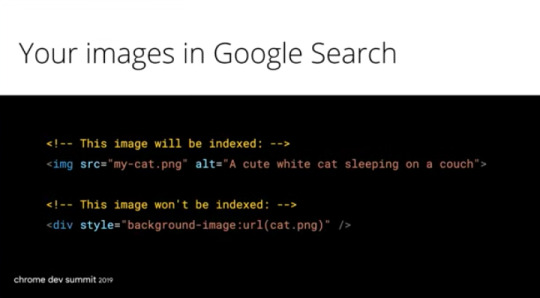
Updates to image search Google is also working towards making image search more useful for users, through better query understanding and by figuring out the context of images. Martin announced that there will be an update coming soon to GSC where webmasters will be able to inform Google, using structured data, that there is a higher resolution version of an image that can be used in image search. This will ensure there is no impact on the performance of your website. Structured data The new structured data types introduced this year included FAQ and How-to markup, which help to make it easier for Google to highlight your website within search results and on voice assistants. Updates to testing tools All of Google’s testing tools are now up to date with the Googlebot rendering engine so there are no discrepancies between the results from testing tools and what is seen by Google. This means tools such as the Mobile Friendly Test, the Rich Results Test and the URL Inspection Tool are using the actual rendering process Googlebot uses and they will continue to update as Googlebot updates. Developers and SEOs Martin concluded his session by talking about something we at DeepCrawl are also very passionate about, Developers and SEOs working together to achieve common goals. By working together, SEOs and developers can become very powerful allies by helping each other with different objectives and prioritisation. This will lead to better content discoverability and generate more traffic to our websites.
Speed Tooling Evolutions: 2019 and Beyond – Paul Irish and Elizabeth Sweeny
Talk Summary Paul Irish and Elizabeth Sweeny from the Google Chrome Web Platform showcased a 15 part blueprint that they created to effectively assess and optimise site performance at Google I/O earlier this year. This talk was a follow on from that, where they dove deeper into optimizing for a users’ experience and using Lighthouse to monitor, diagnose and fix problems. They also explained how a performance score is measured and shared the latest metrics and features available within Lighthouse. Key Takeaways Make sure you are benchmarking with the new metrics which are now available, as these will form the future of Lighthouse scoring. Take advantage of the extensibility of Lighthouse with the Stackpacks and Plugin options. Be mindful of the changes being introduced to Lighthouse and the performance score, which are due to be released early next year. Measuring the quality of a users experience There are two different elements to measuring the performance of a webpage. On one hand there is lab data, which is synthetically collected in a reproducible testing environment and is crucial for tracking down bugs and diagnosing issues before a user sees them. On the other hand, field data allows you to understand what real-world users are actually experiencing on your site. Typically, these are conditions that are impossible to simulate in the lab as there are so many permutations of things including devices, networks and cache conditions.

These metrics are most powerful when they are used together and combined. Tools including Lighthouse, PageSpeed Insights and Search Console allow for monitoring both lab and field data. Without having a clear way to accurately measure the nuances of users experience, it is difficult to quantify the impact that they have on your bottom line or be able to track improvements or regressions. This is why we need to have metrics that evolve, as our understanding and ability to measure a user’s experience also develops. Current performance metrics The metrics currently being used across lab and field data are to capture the load and interactivity of a page, but Google have identified there are gaps with these and opportunities to represent a user’s experience more accurately and comprehensively. For example, metrics such as DOM Content Loaded or Onload measure very technical aspects of a page and don’t necessarily correlate to what a user actually experiences.
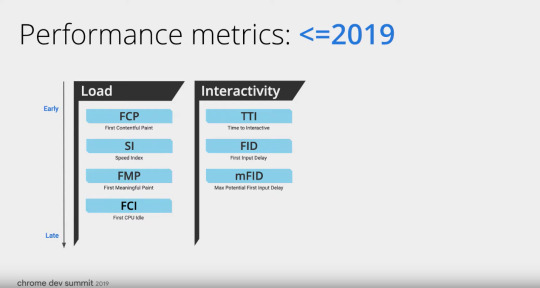
Performance metrics going forwards Moving forwards, Google is looking to fill in as many gaps in the measurement of user experience as possible. This includes some significant shifts to current metrics including a reduced emphasis on First Meaningful Paint and First CPU Idle. Instead, there are new metrics being introduced which are able to capture when a page feels usable. These metrics are; Largest Contentful Paint, Total Blocking Time and Cumulative Layout Shift. They are being used to fill in some of the measurement gaps, while complement existing metrics and provide balance. For example, while Time To Interactive does a good job of identifying when the main thread calms down later in the load, Total Blocking Time aims to quantify how strained the main thread is throughout the load.
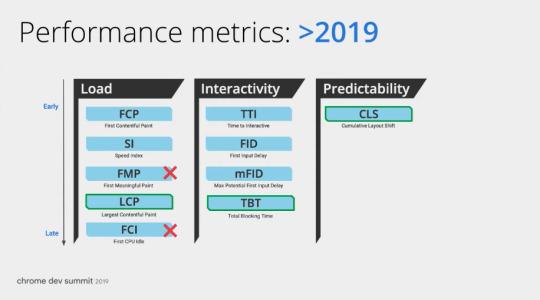
Largest Contentful Paint (LCP) aims to measure when the main, largest piece of content is visible for the user. It catches the beginning of a loading experience by measuring how quickly a user is able to see the main element that they expect and want on a page.

Cumulative Layout Shift (CLS) measures the predictability aspect of a user experience, in addition to load and interactivity metrics. Essentially CLS measures the amount that elements move around during load. For example, just a few pixels moving can be the difference between a user’s happiness, and complete mayhem of accidental clicks or images shifting on a page while it loads. Total Blocking Time (TBT) is used to quantify the risk in long tasks. It does this by measuring the impact of a long task with potential input delay, such as a JavaScript task that is loading an element on a page, for a users interaction on a website. Essentially, it is the sum of “blocking time” between First Contentful Paint (FCP) and Time To Interactive (TTI).
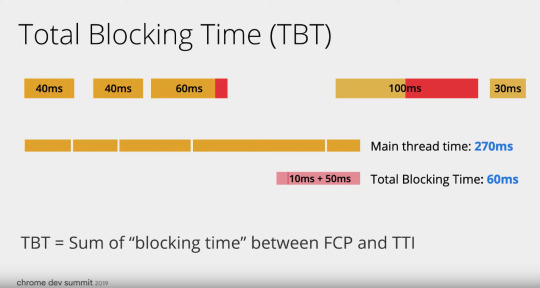
You can find out more about all the metrics used in Lighthouse and how you can measure them, on their dedicated landing page. How the Lighthouse score is calculated The current Lighthouse Performance Score is made up of 5 key metrics that are weighted and blended together to form the 0 - 100 performance score that is populated at the top of the report.

However, this score is going to be updated soon, as Google work to ensure the scoring curves and metrics are reflective of future advancements. This update will be replacing First CPU Idle and First Meaningful Paint with Largest Contentful Paint and Total Blocking Time.
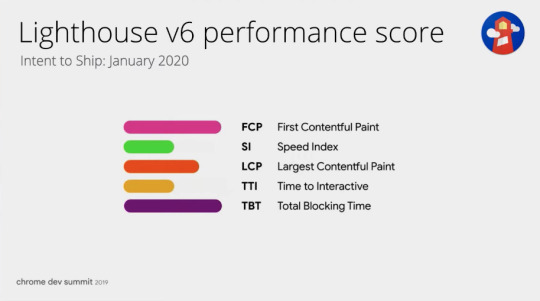
The update isn’t just used to reflect the new LCP and TBT metrics, they are also adjusting the weights to be more balanced between phases of load as well as interactivity measurement. Updates to Page Speed Insights In order to measure a user's experience as accurately as possible, Google has also added a re-analyze prompt to PageSpeed insights for sites which have been redirected to a new URL. This will display a prompt for webmasters to re-run the report for the new URL in order to get the full story of the page, from the redirect to the new page and gain trend insights.

Extending Lighthouse There are two ways you can build on top of Lighthouse in order to leverage it for your own use cases, depending on what your goals are. Stack Packs These allow for stack specific advice to be served within the Lighthouse report itself by automatically detecting whether you are using a CMS or a framework and providing guidance specific to your stack. They take the core audits of lighthouse and layer customised recommendations on top of them, which have been curated by a community of experts. Google announced they are launching further support for frameworks including Angular, WordPress, Magento, React and AMP. Plugins Plugins are allowing the community to build their own plugin specific to what they want to achieve in order to expand from the core audits offered in Lighthouse. This could be to assess things including; security, UX and even custom metrics. Once implemented they will add a new set of checks that will be run through Lighthouse and added to the report as a whole new category. Plugins also allow for customised scoring, so you can decide how things are weighted.
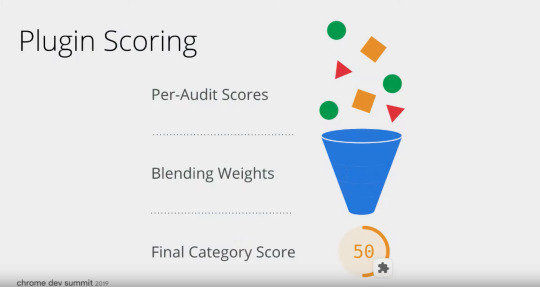
Lighthouse CI We all know how important it is to make sure that fixes to websites are viable and sustainable and be able to show this to the teams that we work with. This is why Google introduced Lighthouse CI. This will allow developers to run Lighthouse on every commit before it is pushed to production. This will allow for transparency and confidence across all teams, in order to see the potential impact of changes made.

PWA and the Installable Web – PJ Mclachlan & Sam Thorogood
Talk Summary In this session, Google’s PJ Mclachlan and Sam Thorogood explored how to ensure PWA’s are created in a way that lives up to users’ expectations and also shared some best practice recommendations for promoting web apps. Key Takeaways When creating web apps it is important to live up to users’ expectations and provide a seamless experience. Not every user is going to benefit from using a PWA, so ensure you define the best audience to promote it to. When promoting a web app on a site make sure you focus on the benefits of installing it and that you are not interrupting a user’s flow. What is web install? Web install is also known as “Add to Homescreen” and is a way to tell users that the website experience is made for their device. However, this could mean one of two things, either it’s just a bookmark that is being added to the homescreen, or it could be an actual integrated experience on the device. PWA’s allow for your website to launch from the home screen and is indistinguishable from a native experience.
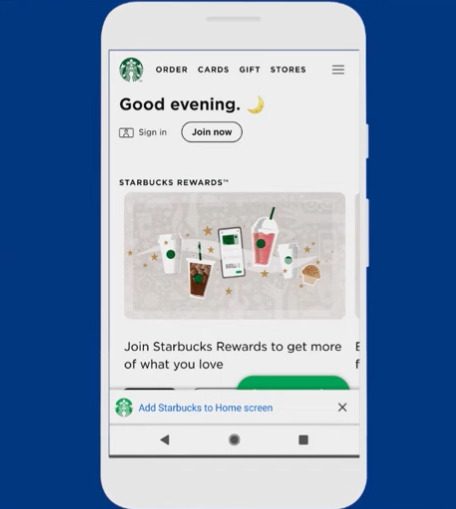
An installed web app is designed to look and feel exactly the same as every other app on a device. It shouldn’t matter to users whether they installed this from an app store, or from the browser itself. Living up to users experiences When asking users to install a web app you are telling them that it is an experience meant for the device they are using, which means that it needs to live up to their expectations. PWAs are a pattern for great apps that use web technology, as they have all the features and functionality users expect from a modern app on mobile or desktop device.

The goal of a PWA is to build directly on the web, so that only one code base needs to be maintained and will work for users both on browsers and through the installed app. Designing for specific users Not every user is going to benefit from the extra power of web apps however, so it is important to define the audience you expect to benefit the most from your PWA. This is done by using a funnel approach to define actions that signal a strong user intent. For example, you might want to only promote the install option to users who frequently visit your site. Most importantly, it’s important to focus on the the user, and why a web app is going to be beneficial for them. You will also want to track the right events in Google Analytics, in order to know what you can optimise, as well as promote web install where it makes sense for a user’s device. Acquiring more installed users There are a few things you can do in order to help acquire more installed users, this includes avoiding channel conflicts and understanding when is best to present users with the option to install. Avoid channel conflicts When promoting your PWA you want to ensure that you’re not creating any channel conflicts by promoting it to people who are currently native app users. There are a number of reasons a user might not be using your native app, but might find benefits in using your web app. The main example of this is due to storage, as native apps can take up a lot of space on a users device. Web apps on the other hand only require a small amount of storage space and the storage that most use is actually dynamically purged from the browser. Google provide the getInstalledRelatedApps API which will allow you to see in JavaScript if a user has your native app already installed. Hide the mini infobar Most PWA installs are happening from the mini info bar, however this was only intended to be temporary as it doesn’t provide the best user experience. Due to being generated by the browser, it has no way of knowing when is the best time to present users with the option to install. In order to ensure the mini info bar doesn’t appear you can add a listener for the beforeinstallprompt event and call the preventDefault( ) method.

It’s also important to implement analytics when performing the above, in order to understand your users’ behaviour with respect to install prompts. The three important events to track are: When the site is qualified for install, with the beforeinstallprompt event. When the prompt has been triggered, for example a ‘click’ event. When the app install has been successfully completed, by using the appinstalled event. UX Considerations There are several UX elements you need to consider when creating a web app, this includes; Disallowing navigation to other domains outside of your site as this can provide a bad experience for users. Instead, make sure you always open external content in a new window. Provide better behaviour for actions such as copy and paste, select all and undo or redo. Disable the right click menu in order to improve the user experience across devices. Where to promote web apps Within the header When using the header to promote web app installs it is important to use information architecture and A/B testing to determine whether it makes sense to place the install option in the header. If you are going to display it within the header, ensure it doesn’t take precedence over other critical functionality. Hamburger menu Another place useful to add the install prompt is within the hamburger menu, this is because it provides a strong signal that users are engaged with the website. However, ensure that it doesn’t add clutter to the menu or take precedence over other actions a user might want to take. Landing Page A landing page is also a great place to promote the install option, as it is a place where you are explicitly marketing your content and you can focus on informing users of the benefits that come with installing your web app. Key engagement moments Promoting the install option within the key moments of engagement in a users journey helps to encourage users to download, as they are in a place of true interest in what you are offering. The main principles for promoting PWA install Don’t be annoying, interrupt a user’s flow or make it difficult for them to complete the task they came to your website for. If the web app is not going to benefit the user, don’t promote the install option to them. Use context to help the user understand the value of installing your app. Read the full article
#chromegoogledev#googlechromedev64#googlechromedevapk#googlechromedevblog#googlechromedevbuild#googlechromedevexe#googlechromedevmode#googlechromedevsummit#googlechromedevx86#googlegooglechromedev#googleseoads#googleseoguide#googleseojobs#googleseokeyword#googleseotools#googleseoom#googleseoul#seogoogleadsexplorers.com#seogoogleownsads.com#seogooglepublicityad.com
0 notes
Text
Robots.txt Noindex Update: Everything SEOs Need to Know

How Robots.txt Noindex used to work
Despite never being officially documented by Google, adding noindex directives within your robots.txt file had been a supported feature for over ten years, with Matt Cutts first mentioning it back in 2008. DeepCrawl has also supported it since 2011. Unlike disallowed pages, noindexed pages don’t end up in the index and therefore won’t show in search results. Combining both noindex and disallow in robots.txt helped to optimise crawl efficiency, with the noindex directive preventing the page from showing in search results, and the disallow stopping it from being crawled: Disallow: /example-page-1/ Disallow: /example-page-2/ Noindex: /example-page-1/ Noindex: /example-page-2/
An update to unsupported rules
On July 1st 2019, Google announced that the Robots Exclusion Protocol (REP) was becoming an internet standard, after 25 years, as well as now being open source. They followed this on July 2nd with an official note on unsupported rules within robots files. This announcement informed us that, effective September 1st 2019, the use of noindex within robots.txt will no longer be supported by Google. Gary Illyes explained that after running analysis around the use of noindex in robots.txt files, Google found “the number of sites that were hurting themselves was very high.” He also highlighted that the update “is for the better of the ecosystem and those who used it correctly will find better ways to achieve the same thing.”

Gary "鯨理/경리" Illyes ✔@methode As promised a few weeks ago, i ran the analysis about noindex in robotstxt. The number of sites that were hurting themselves very high. I honestly believe that this is for the better for the Ecosystem & those who used it correctly will find better ways to achieve the same thing. https://twitter.com/googlewmc/status/1145950977067016192 … Google Webmasters ✔@googlewmc Today we're saying goodbye to undocumented and unsupported rules in robots.txt

If you were relying on these rules, learn about your options in our blog post.https://webmasters.googleblog.com/2019/07/a-note-on-unsupported-rules-in-robotstxt.html?m=1 … 91 10:06 AM - Jul 2, 2019 · Zurich, Switzerland Twitter Ads info and privacy 52 people are talking about this
Alternative options to the noindex directive
If you are currently relying upon the noindex directive within your robots.txt file, there are a number of alternative options, as listed within Google’s official blog post; Noindex robots meta tags: This is the most effective way to remove URLs from the index but still allow crawling. These tags are supported in both the HTTP response headers and HTML and are achieved by adding a meta robots noindex directive on the web page itself. 404 and 410 HTTP status codes: These status codes are used to inform search engines that a page no longer exists, which will lead to them being dropped from the index, once they have been crawled. Password protection: Preventing Google from accessing a page by hiding it behind a login will generally lead to it being removed from the index. Disallow in robots.txt: Blocking a page from being crawled will typically prevent pages from being indexed, as search engines are only able to index the pages they know about. While a page may be indexed due to links pointing to it from other pages, Google will aim to make the page less visible in search results. Search Console Remove URL tool: The URL removal tool within Google Search Console is a quick and easy way to temporarily remove a URL from Google’s search results.
Identify and monitor your noindex robots.txt pages
Ahead of the support for robots.txt noindex directives ending on September 1st 2019, the Noindex Pages Report in DeepCrawl (via Indexation > Non-Indexable Pages > Noindex Pages) will allow you to check which of your pages are currently being noindexed and how. Within the list of noindexed pages you will be able to see where they have been noindexed: through the header, meta tag or robots.txt.
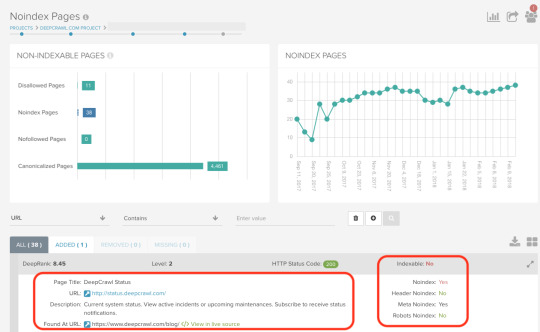
Discover this report, and over 200 others, by trying us out for yourself with a free trial. You can also test how your noindex directive is working in the Search Console testing tool, as you would with any other Robots.txt directive (in Crawl > robots.txt Tester).

Other changes to Robots.txt
This update is just one of a number of changes coming to the robots.txt protocol as it works towards becoming an internet standard. Google have explained these further in their updated robots.txt specifications document on the Google Developers blog. Read the full article
#robots.txtblockall#robots.txtchecker#robots.txtcomment#robots.txtdenyall#robots.txtdisallowall#robots.txtexample#robots.txtfile#robots.txtgenerator#robots.txtsitemap#robots.txttester
0 notes
Text
illustration #2













https://www.behance.net/gallery/55907787/GOING-NORTH-3?tracking_source=curated_galleries Read the full article
#illustrationart#illustrationboard#illustrationdefinition#illustrationessay#illustrationessaytopics#illustrationexchange#illustrationfriday#illustrationlibrary#illustrationmeaning#illustrationsby
0 notes
Text
illustration #1







https://www.behance.net/gallery/55618461/Illustration-Collection?tracking_source=curated_galleries














İlham Panosuna Ekle


Read the full article
#illustrationart#illustrationboard#illustrationdefinition#illustrationessay#illustrationessaytopics#illustrationexchange#illustrationfriday#illustrationlibrary#illustrationmeaning#illustrationsby
0 notes
Text
Google ramps up investment in wearable technology, enters deal to buy Fitbit for $2.1 billion

Google parent Alphabet is buying fitness tracker and smartwatch maker Fitbit in a deal that values the company at $2.1 billion. Android Wear devices have not kept up with the Apple Watch, which dominates the wearables market (along with AirPods). Catching Apple Watch. In its recent earnings release, Apple announced that its “Wearables, Home and Accessories” revenues grew to $6.5 billion from $4.2 billion a year ago. And according to third party analyst estimates, the Apple Watch represents roughly 50% of the global wearables/smart watch market. Alphabet’s acquisition of Fitbit is not unlike Google’s purchase of other hardware companies (e.g., Motorola, HTC) in order to speed innovation and build “reference products” that are more integrated and better performing than those of its OS licensing partners. Like the Pixel Phone for wearables. Google will use the acquisition to build next-generation wearables according to Rick Osterloh, Senior Vice President, Devices & Services. He said in a blog post that the company sees “an opportunity to invest even more in Wear OS as well as introduce Made by Google wearable devices into the market . . . By working closely with Fitbit’s team of experts, and bringing together the best AI, software and hardware, we can help spur innovation in wearables and build products to benefit even more people around the world.” The Fitbit successor devices that emerge from this acquisition will feature Google Assistant front and center. Indeed, we’re now entering the era of so-called “ambient computing,” where an emerging array of connected devices takes center stage — and to some degree takes over from smartphones. Apple’s Watch and Airpods are the two most prominent success stories. However, Amazon launched a number of new non-screen devices at its last hardware event, including Echo Frames (Alexa-enabled glasses) and its well-reviewed Echo Buds (Alexa-enabed earbuds). Why we should care. Google Assistant is becoming the focus of the Google cross-platform user experience and with it the conversational UI. BERT‘s importance thus comes into sharper relief as a key technology/tool for understanding more and more spoken commands and queries. And though “voice search” hasn’t lived up to the hype (yet), it’s the key interface that links experiences across Google’s growing array of connected devices. Read the full article
0 notes